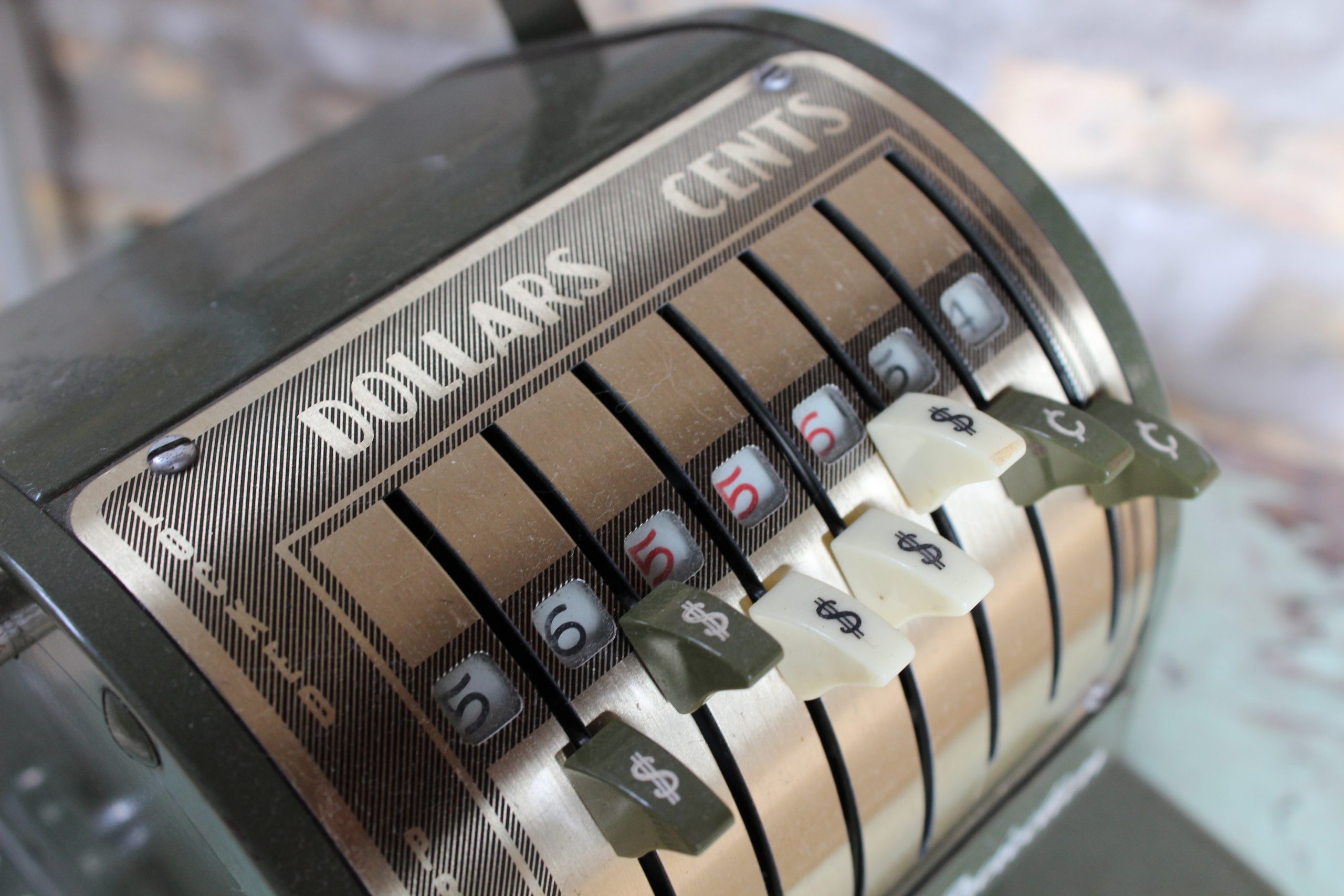
Museum Artifact: Paymaster Series X-550 Check Writer Machine, 1960s
Made By: The Paymaster Corp., 1811 W. Winnemac Ave., Chicago, IL [Ravenswood]
“The only way to have the Paymaster system when you NEED it is to have one all the time—NOW!”—tagline from 1951 Paymaster sales manual
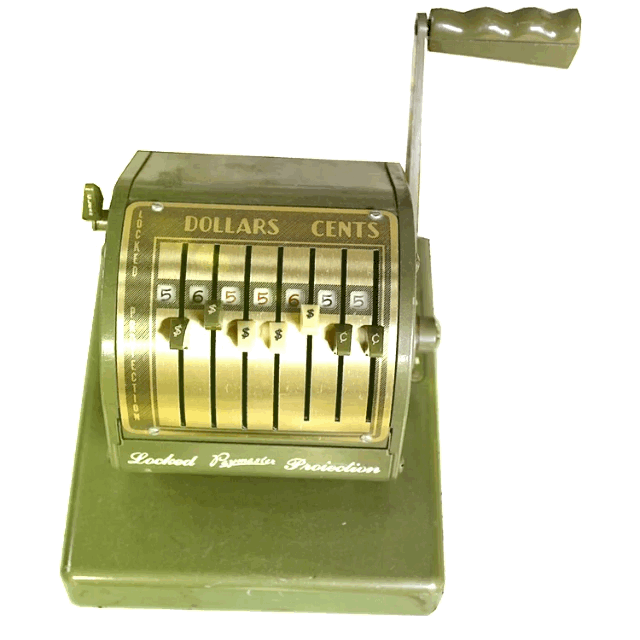
Often kept well out of sight in the backrooms of banks and the HR departments of small businesses, the nearly 15-pound Paymaster X-550 Check Writer had the heft and durability of a small burglary safe. Only, instead of storing cash in it, this magical machine produced its own money . . . in a manner of speaking. As the name would suggest, a pull of the Paymaster’s handle activated an internal pressure bar and ink rollers, which then stamped down the monetary value (selected via the levers under “DOLLARS” and “CENTS”) on to an inserted blank check.
Devices like this were the integral conduits through which millions of paychecks and billions of dollars were distributed to workers for much of the mid-to-late 20th century. They were also the best friend of the business owner, as the tiny pin-point perforations the machine created in each check offered a useful defense against fraudsters.
There were several large national manufacturers of check writers (aka check protectors), including Chicago’s Hedman MFG Co., makers of the F&E Check Writer. The biggest name in the business after WWII, however, was the Paymaster Corporation, whose army of freelance salesmen helped put new models like the X-550 in offices from Fort Bragg, California to Fort Bragg, North Carolina. Each of those machines was manufactured at Paymaster’s Chicago factory, produced by a dedicated workforce that excelled and bonded with one another in the face of an often unsympathetic, union-busting executive board.
Workers at the Paymaster factory, 1811 W. Winnemac Ave., 1960s
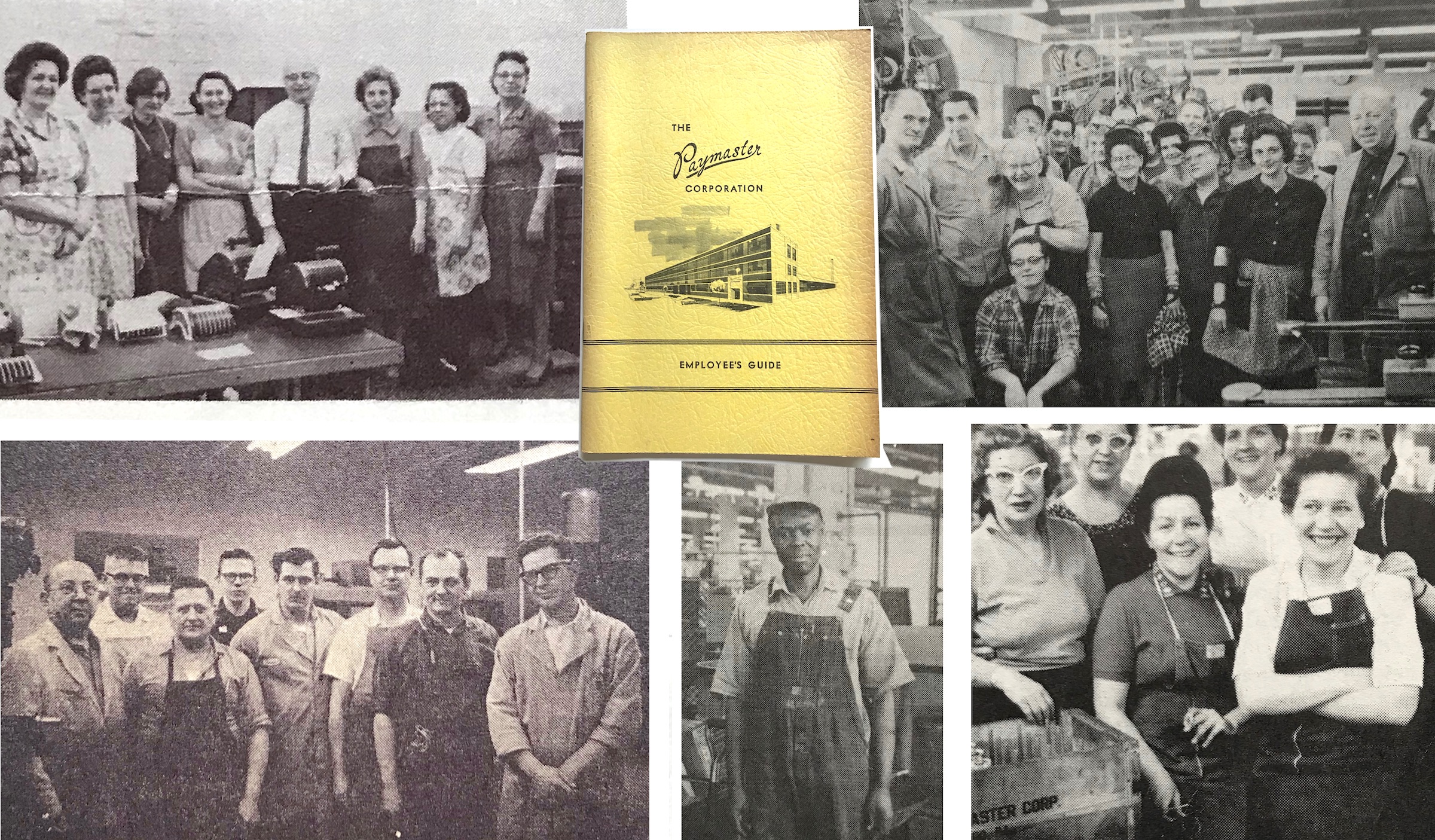
Top Left: Assembly Department Inspectors, 1965. Left to Right: Mary Westerberg, Bernice Cawlik, Rita McDermott, Mary Tsuruda, Joe Puncochar, Stella Zelasko, Beverly Hubert, and Martha Sandberg.
Top Right: Punch Press Department, 1964. Howard Lineweaver in front. First row from left: Al Thompson, Sam DeFrancisco, Harriet Block, Tilly Terry, Beatrice Felde, Marie White, and ‘The Boss’ George Tucker. In rear from left: Earl Wise, Kaz Okimoto, Eva Rivers, Henry Schalk, John Carlson, Marie Waugh, Clarence Featherkile, Charlotte Mayer, Gene Freeman, Geraldine Schrankel.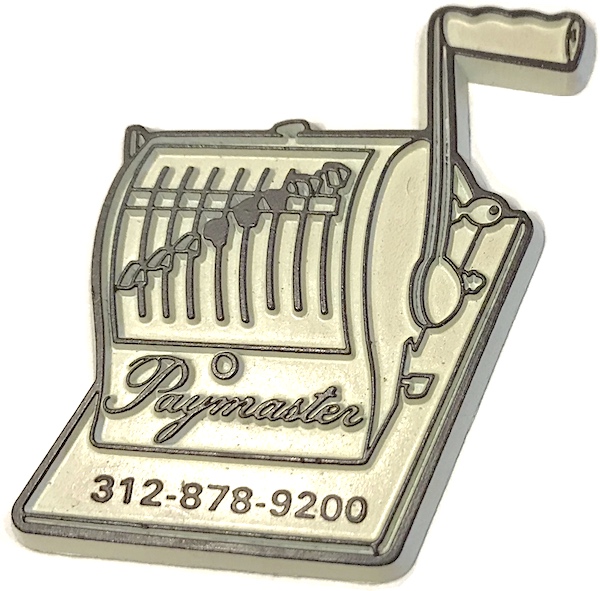
Bottom Left: Tool Room, 1968. Left to Right: John Czarnik, Stanley Kwiatek, Charles Overly, Gene Blum, Frank Koy, Leroy Holm, Thaddeus Superson, and Edward Guth.
Bottom Center: J. L. Linson, Tumbling Department, 1964
Bottom Right: Machine Operators, 1960. First row from left: Alma Danowski, Pernia Kapellusch, and Barbara Regert. Back Row: Leona Poterske, Gert Nicholas, and Dorothy Wagner.
History of the Paymaster Corp., Part I: Checks and Balances
The business that would become the Paymaster Corporation was organized in Chicago in 1917 as the Checkometer Sales Company. Its original product, unsurprisingly called the “Checkometer,” was the invention of a Chicagoan named George M. Willis, but it was an experienced salesman from St. Louis, Theodore B. Hirschberg, who turned the idea into an enterprise.
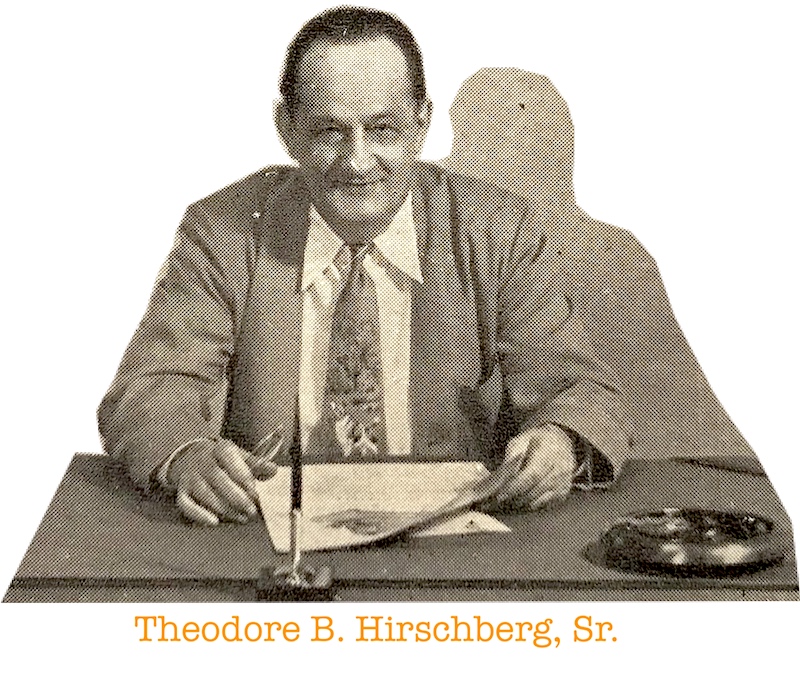 Hirschberg’s opportunistic endeavor came during an era when check fraud was emerging as a national scourge and new defense technology was in desperate demand. Modern bandits known as “penmen,” “scratchers,” or “check raisers” had figured out that America’s rapid move away from old-fashioned cash transactions had created a whole new method of weapons-free criminality. By fudging the numbers on a check with some skillful penmanship, a scratcher could rob a business of thousands of dollars in broad daylight, literally smiling all the way to the bank. Better still, if he got caught, the docile nature of the robbery often led to appealingly light sentences.
Hirschberg’s opportunistic endeavor came during an era when check fraud was emerging as a national scourge and new defense technology was in desperate demand. Modern bandits known as “penmen,” “scratchers,” or “check raisers” had figured out that America’s rapid move away from old-fashioned cash transactions had created a whole new method of weapons-free criminality. By fudging the numbers on a check with some skillful penmanship, a scratcher could rob a business of thousands of dollars in broad daylight, literally smiling all the way to the bank. Better still, if he got caught, the docile nature of the robbery often led to appealingly light sentences.
“If someone uses a gun to steal money and gets caught, they get up to to 20 years for using a weapon,” Paymaster salesmen would often point out, “but if a person is caught stealing money with a pen, they get one to three years, with a good possibility of being out in eight months. After all, it’s the safest and easiest way to steal money.”
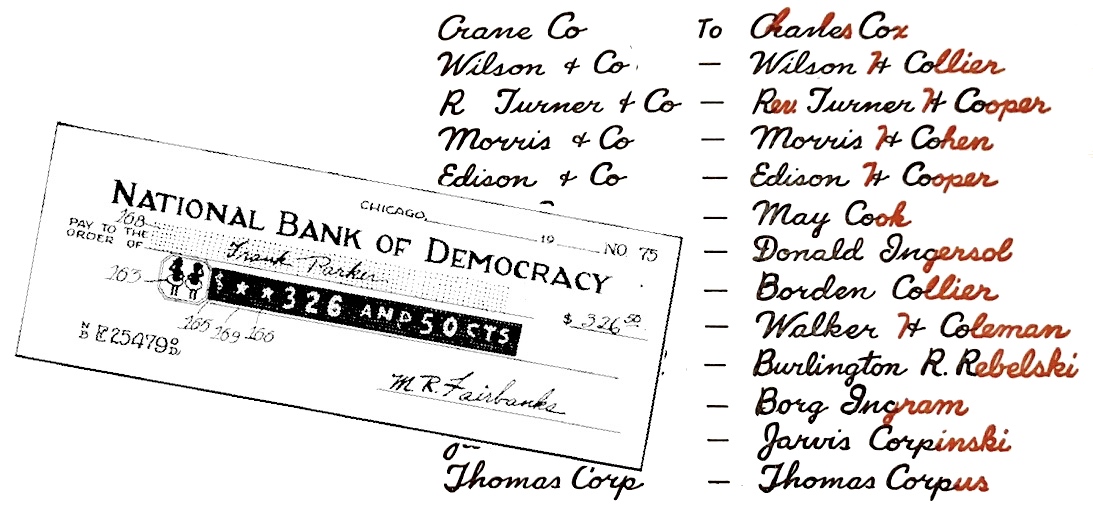 [Left: 1921 patent image from George Willis’s design for a forge-proof check, produced by his Checkometer device. Right: Examples of how a company’s name can be altered by hand on a traditional check, from a Paymaster sales book]
[Left: 1921 patent image from George Willis’s design for a forge-proof check, produced by his Checkometer device. Right: Examples of how a company’s name can be altered by hand on a traditional check, from a Paymaster sales book]
Scare-tactic sales pitches worked quite effectively on nervous business owners, and it soon began to feel like an absolute necessity to arm one’s office with an advanced check protector that could punch, print, and watermark paychecks in a way that no forger, in theory, could duplicate. Early versions of these machines existed back in the late 1800s, but by the coming of World War I, a few big names—including the Hedman Company and the Todd Protectograph Company (Rochester, NY)—were leading the industry.
Entering this field behind George Willis’s efficient design, the new Checkometer Sales Company not only had to establish itself as a viable office equipment business, but as a sort of national security operation, as well. Trust was of the utmost importance.
In order to build that trust with his customers, however, Theodore Hirschberg had to start by breaking the trust of his previous employer.
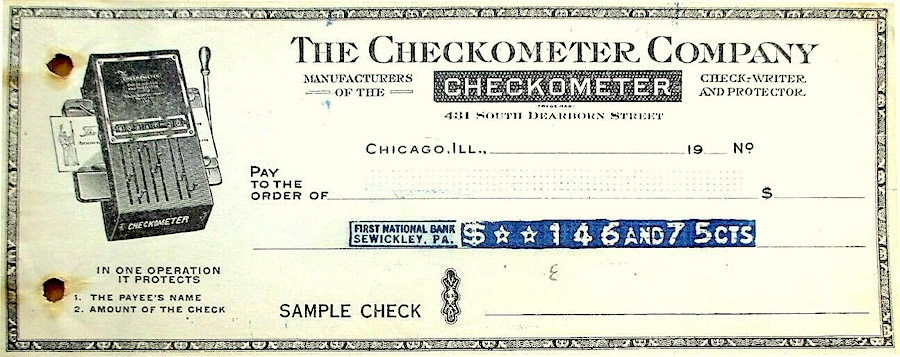
II. Traitor Ted
Theodore B. Hirschberg Sr. (1884-1963) was born in Missouri, the son of a Jewish optician who’d immigrated from Germany to St. Louis in the 1860s—Anheuser-Busch style. In his 20s, young Ted became a Midwest regional salesman for the leading checkwriter manufacturer of the day, the aforementioned Todd Protectograph Co. of Rochester, New York; then known as G.W. Todd & Co.
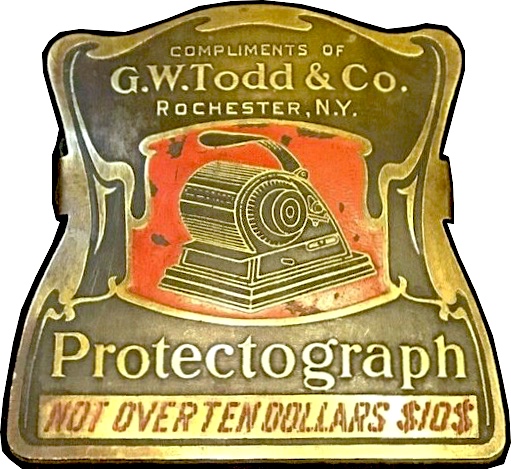 For several years, Hirschberg learned the nuances of the trade from seasoned vets, absorbing the inner-workings of the patented “Protectograph” machine the firm was producing. He also used Todd’s customer list to build a network of connections in St. Louis and beyond. As tends to happen with the most ambitious salesmen, however, Hirschberg gradually became disenchanted with life as a regional underling. He fancied himself an under-appreciated star player in the Todd galaxy, and at age 32, decided it was time to make something of his own.
For several years, Hirschberg learned the nuances of the trade from seasoned vets, absorbing the inner-workings of the patented “Protectograph” machine the firm was producing. He also used Todd’s customer list to build a network of connections in St. Louis and beyond. As tends to happen with the most ambitious salesmen, however, Hirschberg gradually became disenchanted with life as a regional underling. He fancied himself an under-appreciated star player in the Todd galaxy, and at age 32, decided it was time to make something of his own.
Despite the existence of a clearcut non-compete clause in his contract, the cavalier Hirschberg broke out and launched the aggressively competitive Checkometer Sales Company in 1917, unashamedly poaching former G. W. Todd clients in the process, and even allegedly using some of Todd’s mechanical specs in order to fine-tune George Willis’s Checkometer.
G.W. Todd & Co. countered by taking Hirschberg to the Supreme Court of Monroe County, New York, in the summer of 1917, accusing their former cadet of the fairly severe offense of “revealing trade secrets to a competitor.”
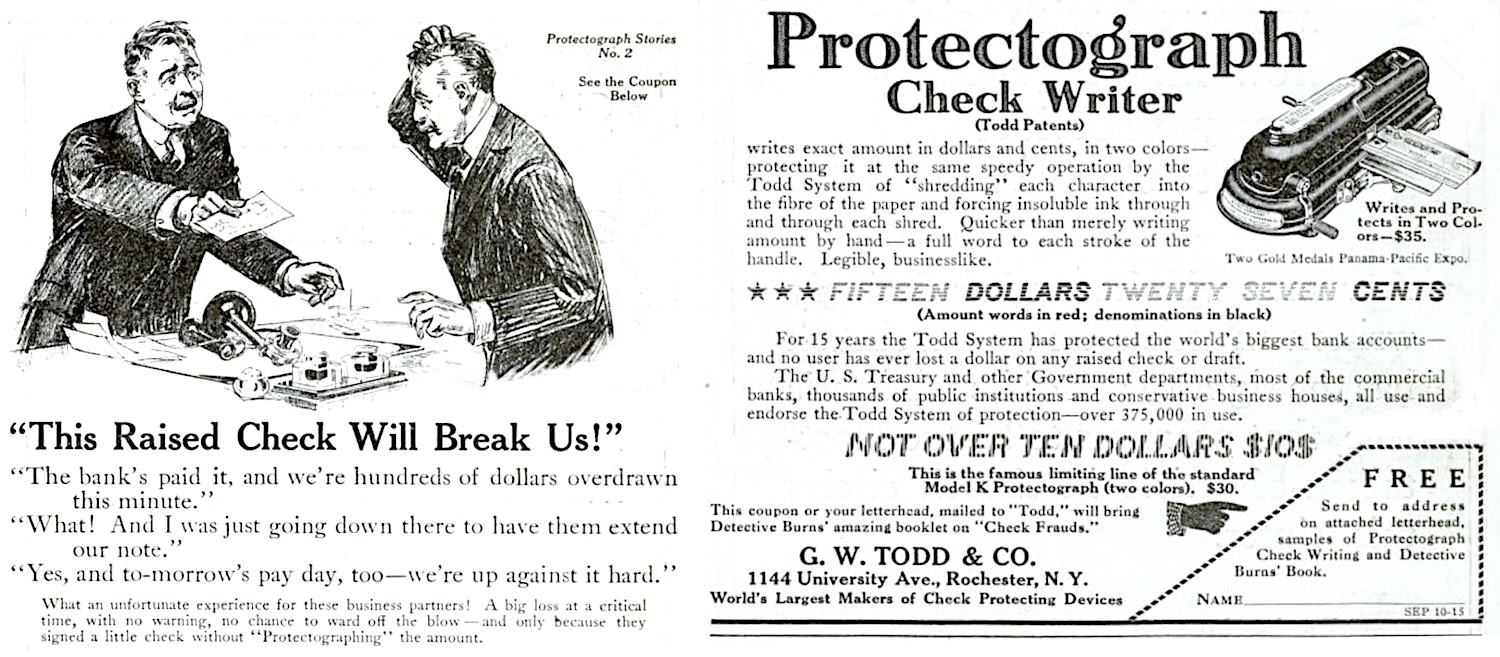
“The defendant entered into a written contract with the plaintiff,” the Todd lawyers argued, “in which he stipulated that he would not reveal any confidential information obtained during his employment and would not enter the employment of a competitor within one year after the termination of the contract. The contract was broken by the defendant and he now claims that the contract is void.
“At the very outset the defendant is confronted with his contract and with his violation thereof. If the contract is a reasonable one under all the circumstances it should be enforced. The defendant came into possession of the list of plaintiff’s customers in the territory where he was assigned, and of a scrapbook containing confidential information. He was made acquainted with some new improvements in the devices which were being manufactured by the plaintiff, and generally became familiar with the plaintiff’s sales system organization and trade methods. These features formed an important part of the successful operation of plaintiff’s business and it was reasonable that it should seek to preserve this information for its own use.”
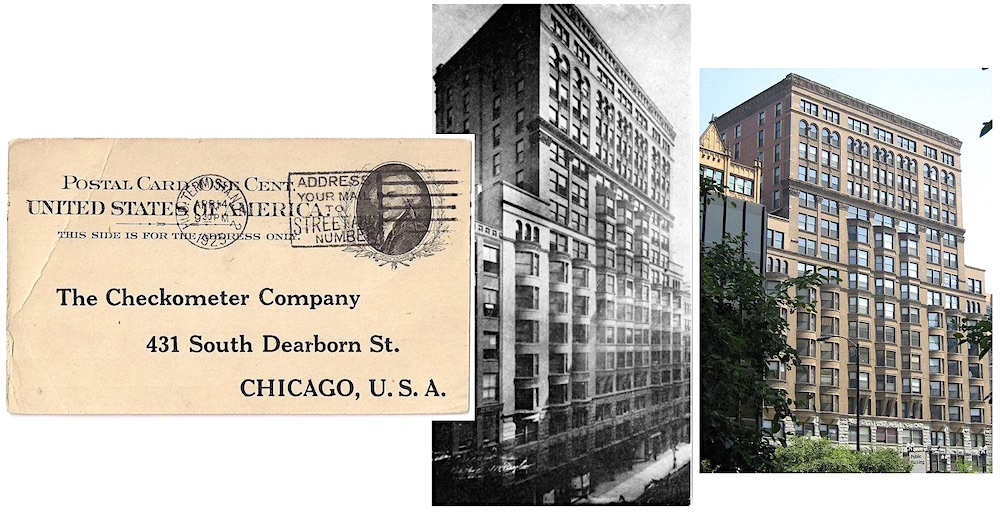
[Paymaster / Checkometer’s first home office was located in Chicago’s Manhattan Building, seen above then and now, at 431 S. Dearborn Street]
In the short term, Todd succeeded in getting an injunction against Hirschberg and the Checkometer, but it didn’t dissuade the turncoat for long. In fact, the case may have lit a bigger fire under Hirschberg, as he subsequently bought out the Willis patents for himself and incorporated the Checkometer Sales Company in 1920. An official press release of the time read as such:
“Chicago, ILL—The Checkometer Sales Company, room 1119, 431 South Dearborn street, has incorporated with capital stock of $25,000. The objects are to manufacture and deal in check writing and protecting machines, typewriters, etc. The Checkometer is distributed. The incorporators of the company are Flavan Bayad, T.B. Hirschberg, Theo. B. Hardy.”
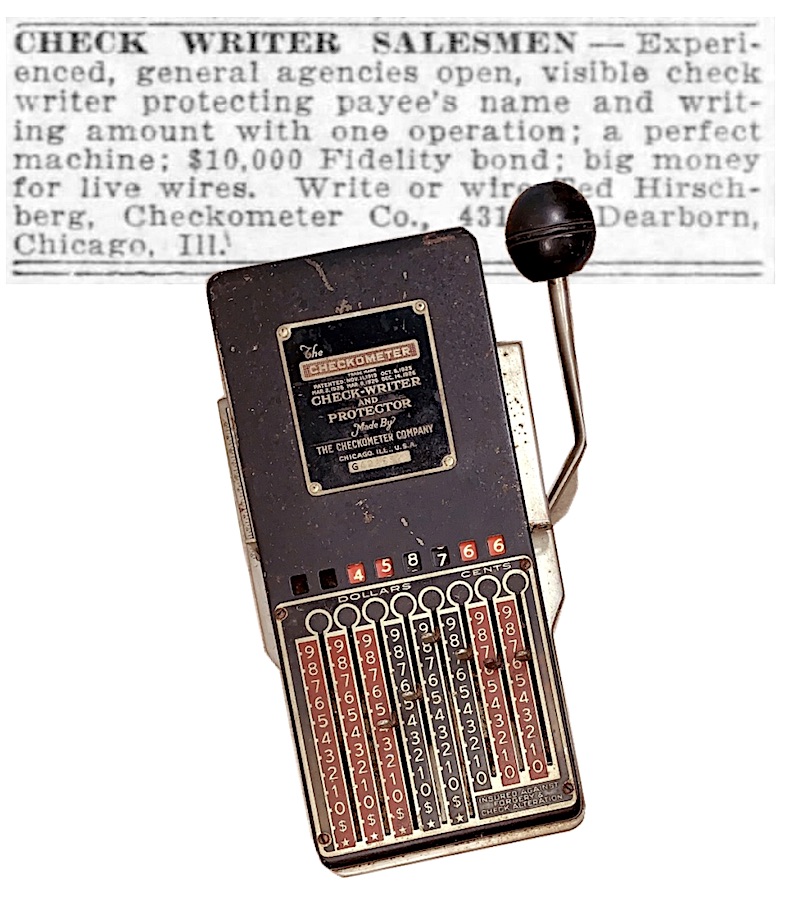 Recruiting an expert sales team and utilizing that long-established network of connections from his Protectograph days, Hirschberg set about touting the Checkometer as the preferred check writer of the Jazz Age.
Recruiting an expert sales team and utilizing that long-established network of connections from his Protectograph days, Hirschberg set about touting the Checkometer as the preferred check writer of the Jazz Age.
“The Checkometer makes almost impossible the criminal alteration in a check after its drawing,” read one 1923 advertisement. “Simple in build and quick of operation, it effectually blocks a doorway through which thousands of crooks have found access to ‘easy money.'”
Being the Roaring ’20s and all, Hirschberg also rewarded himself for his efforts by dramatically upgrading his lifestyle. Having already parted ways with his first wife Helene (mother of Theodore Jr.), Hirschberg remarried in 1923, partnering with a young proto-hippie from Colorado named Louise Talmage—future author of an obscure spiritual/meditation book called I Am Creative Holiness. The newly minted millionaire couple threw themselves into Chicago’s high society nightlife, and by the late ’20s, they were spending much of their time in their second home—a Spanish Revival / Art Deco mansion in the Sherman Oaks section of Los Angeles.
According to a story in the Los Angeles Times many years later, “the flamboyant Theodore B. Hirschberg” was known for hosting “extravagant parties” at the house, “which many Hollywood stars attended. Some neighbors say Mae West and then P. T. Barnum lived in the 18-room mansion after Hirschberg.”
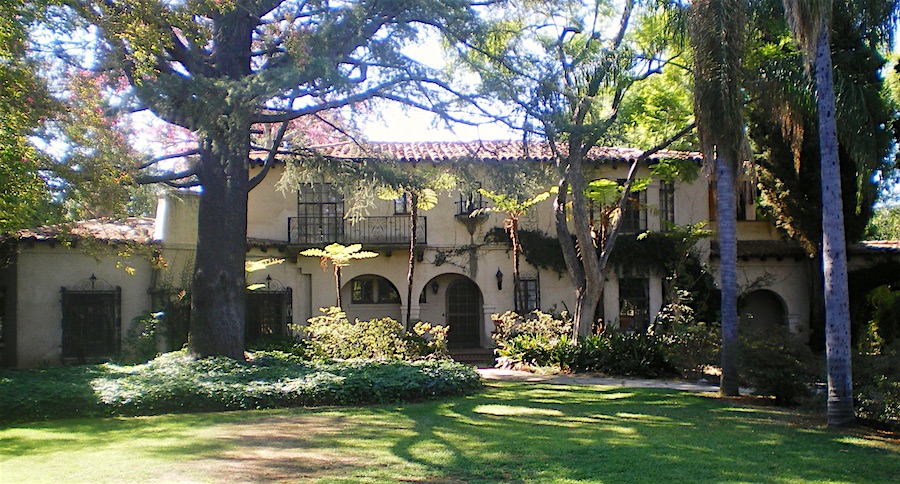
[The “Magnolia House” in Sherman Oaks, CA; Ted Hirschberg Sr.’s giant home away from home]
A less famous but more consequential guest to the mansion was Theodore Hirschberg, Jr., who appears to have come to L.A. to live with his dad for a time in the late 1920s, when he was around 20 years old. Whether he held a grudge against his absentee father or not, young Ted Jr. was probably unavoidably impressed by the swanky lifestyle those check machines had earned his papa. And when the stock market crash threatened that family empire later that same year, Ted Jr. might have found all the impetus he needed to follow in his father’s footsteps—no matter what might stand in the way.
III. Dollars and Sense
In the wake of the 1929 crash, while other businesses were folding left and right, a new era began for the Hirschbergs. As a company literally built on the concept of helping people protect their money, Checkometer was, in some ways, well positioned for survival in the Depression, but it was soon deemed that a bit of rebranding might do the business good. The introduction of the first “Paymaster” machine thus followed in 1932, which then necessitated a corresponding corporate name change. For most of the 1930s, the company operated as the American Check Writer Company, before finally re-incorporating in 1940 as the Paymaster Corporation.
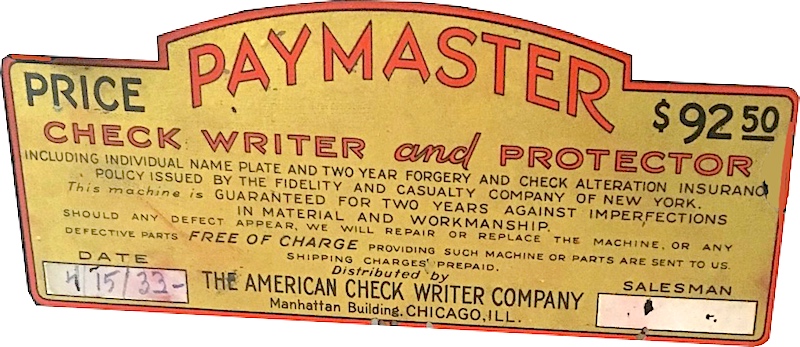 Of course, all grand plans for the new corporation were side-tracked for a good four years during World War II, as the Paymaster plant at 754 W. Lexington Street was converted over to military contracting, making parts for various planes and guns. Within days of V-J Day, however, those contracts were swiftly canceled, and new Paymasters were finally rolling off the lines again.
Of course, all grand plans for the new corporation were side-tracked for a good four years during World War II, as the Paymaster plant at 754 W. Lexington Street was converted over to military contracting, making parts for various planes and guns. Within days of V-J Day, however, those contracts were swiftly canceled, and new Paymasters were finally rolling off the lines again.
With Ted Sr. now serving as Chairman and spending most of his time in California, Theodore Hirschberg, Jr., ascended to the company presidency and oversaw the day-to-day activities of the Paymaster Corp. in Chicago. His father and stepmom would sometimes return to the city in the 1940s, renting an apartment in the Edgewater Beach Hotel, but for all intents and purposes, the post-war success of the business was in the hands of Ted Junior.
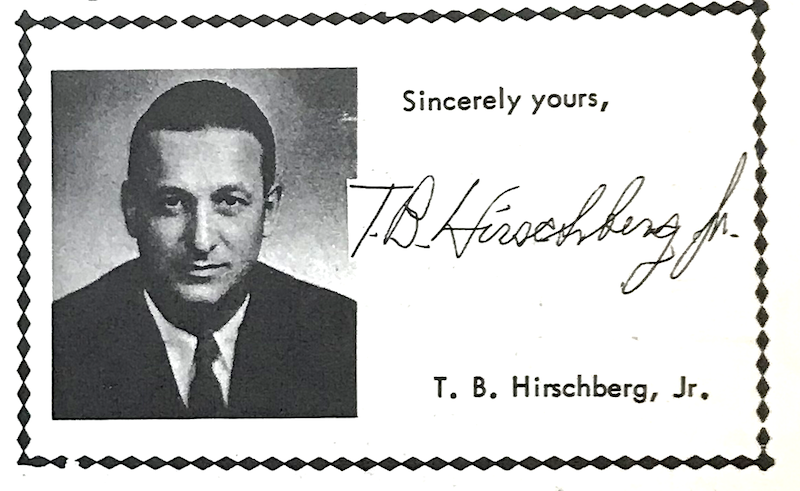 T.B. Hirschberg, Jr., as you will learn momentarily, was a flamboyant character in his own right, and not in a way that necessarily endeared him to his employees. His views on union organizing, in particular, would lead to many a clash in the years ahead. In terms of pure economics, though, he was clearly pushing some correct buttons.
T.B. Hirschberg, Jr., as you will learn momentarily, was a flamboyant character in his own right, and not in a way that necessarily endeared him to his employees. His views on union organizing, in particular, would lead to many a clash in the years ahead. In terms of pure economics, though, he was clearly pushing some correct buttons.
By 1956, Paymaster had completely outgrown its Lexington Street plant, and moved further north to the edges of Uptown and Ravenswood; taking over a large facility at 1811 W. Winnemac Avenue, with additional offices at 224 S. Wabash Avenue. Initially, Hirschberg leased out half the Winnemac factory to other businesses, but over the next decade, Paymaster ultimately needed the entire complex, and a three-story addition, to meet demand.
Like his dad, Hirschberg Jr. made sure he understood the ins and outs of the machines he was manufacturing, and Paymaster remained ahead of the curve by scooping up patents on any and all new breakthroughs in the field. Mechanical engineers including Arthur G. Rindfleisch, Alfred E. Little, Hubert Jagger, and Ardath Gopperton were all put into Paymaster employ during the ’50s and ’60s, tweaking everything from the ink rolls to the security of the machines themselves (including the installation of an alarm system).
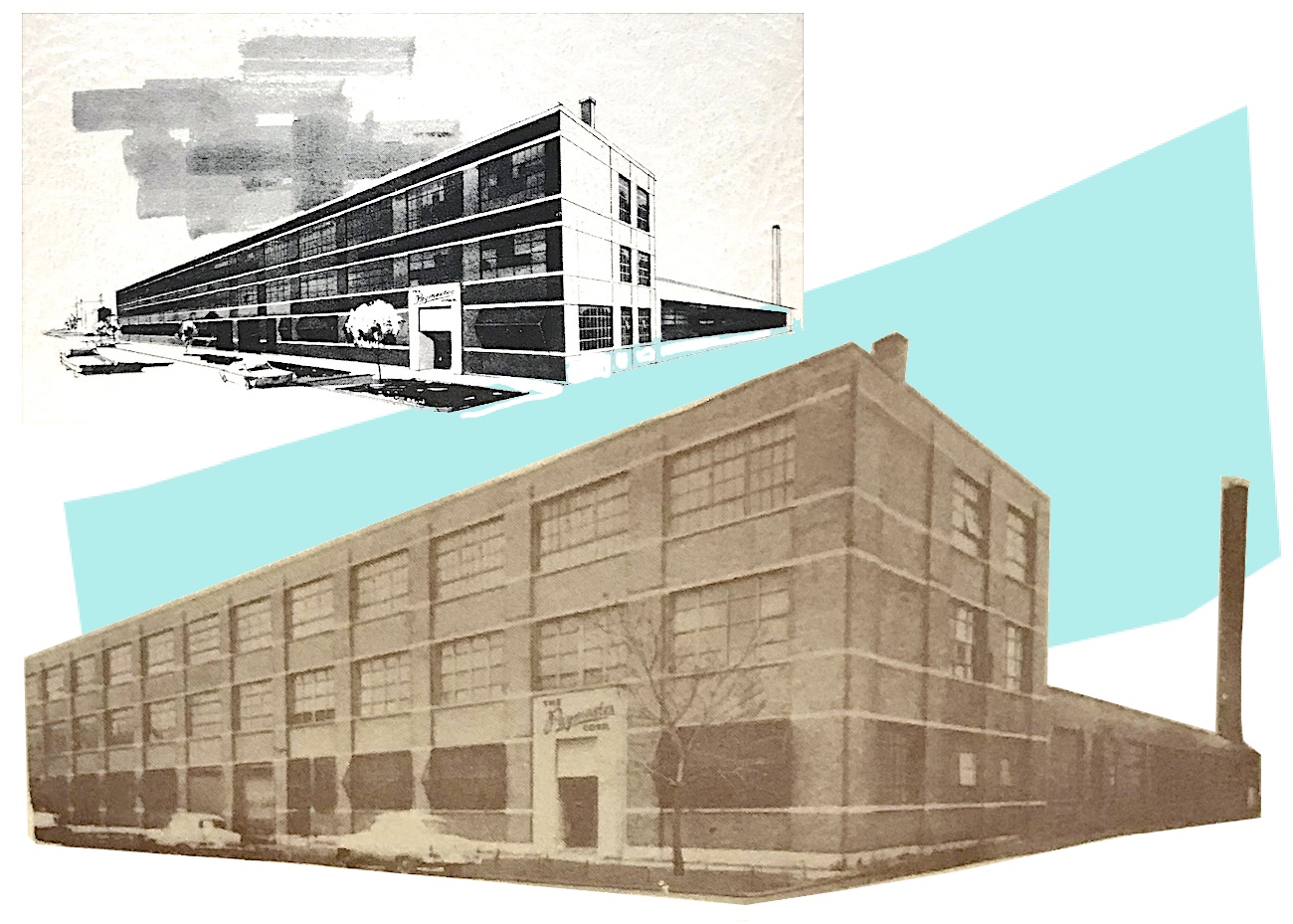
[Two 1960s views of the Paymaster factory at 1811 W. Winnemac Avenue. The building has since been demolished and replaced with walk-up apartments.]
Ironically, check protectors did sometimes pose their own security risks, since a disgruntled employee could theoretically use the machine to create a $99,999.99 payout much in the way the old-school “scratchers” used to. That’s why Paymasters came with a lock and key. It was usually just the business owner and one trusted employee in human resources who had the power to pull the lever.
Early Paymasters required ink rollers and they dried out quick, so you had to be sure you were well stocked before holiday bonus season. Using a machine also generally meant paying a monthly services fee (about $10) directly to Paymaster, whether you were a small business or a big bank. Those fees went to Hirschberg’s Wabash office, and were another example of his ability to sniff out a smart business opportunity. What’s better than an expensive office product? An expensive office product that you never stop paying for.
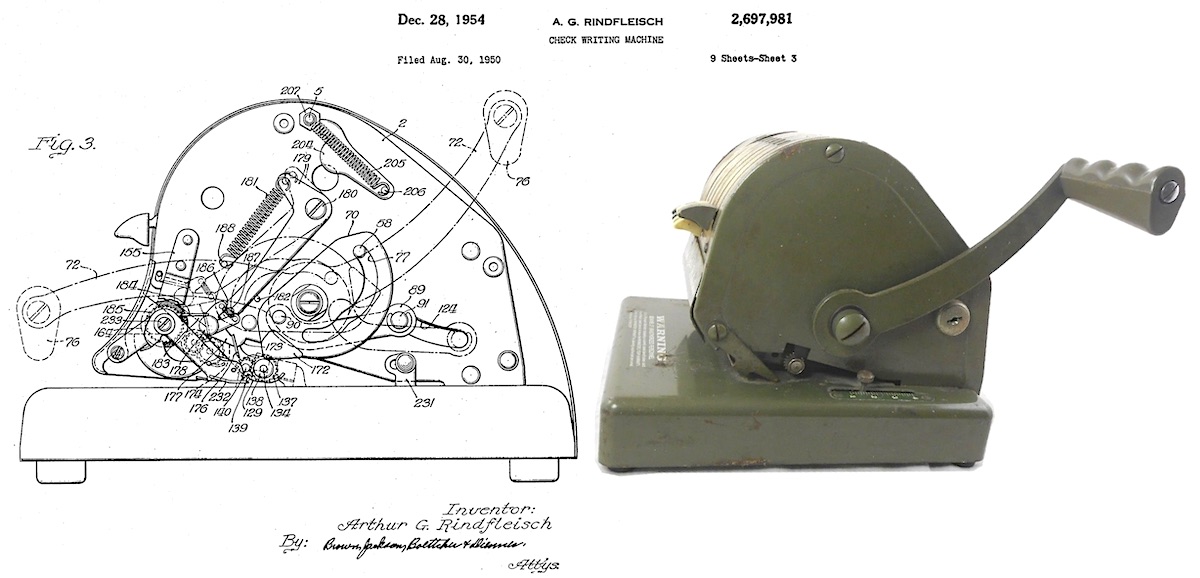
[Patent image from a Paymaster check writer developed by Arthur G. Rindfleisch, 1950]
IV. Hanna & Don Hall: A Paymaster Love Story
On September 17, 1958, a 26 year-old Finnish-American named Hanna Markko was hired to work at the Paymaster plant on Winnemac Avenue. Hanna had been working in factories since the age of 16, when she dropped out of high school to join the assembly line of the Fisher Pen Company at 757 Waveland Ave. Now recently divorced and raising a six-year old son, Hanna hoped working for Paymaster would provide some long-term financial stability. As her son William told the Made In Chicago Museum, it provided far more than that, as Hanna would ultimately meet her second husband at Paymaster (Don Hall, William’s adopted father) and celebrate 30 years of employment with the business.
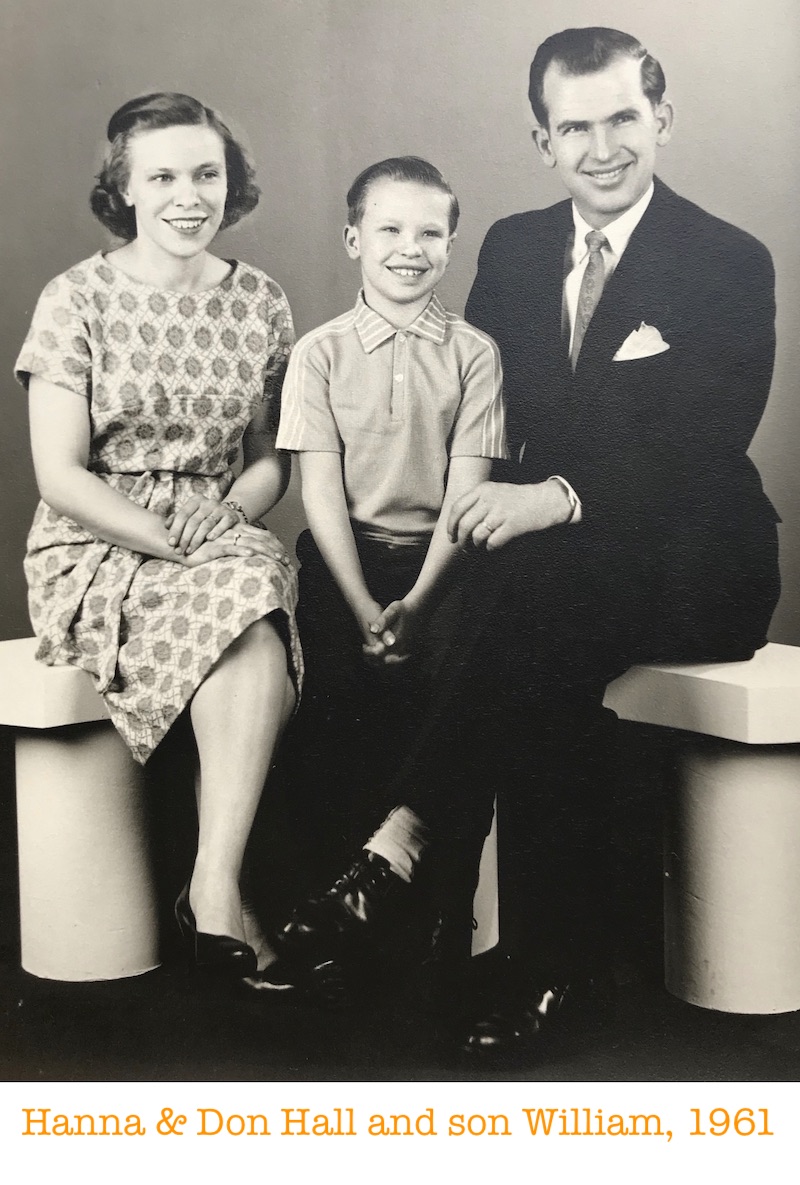 “My mother worked at various points and times in the Assembly Department, on the Ink Roll Line, Paint Department, and in Sub-Assembly,” William Hall recalls. “Over the years, she learned every job housed within each of these departments. She was so good at each job, she was used to ‘set the rate’ excepted for each one. Even when engineering and the punch press departments produced new and improved product designs, Hanna was shown how to do the assembly, then she would be told to work as fast as she could for one hour. The piece-work rate expected per hour was then set at one-half the number of pieces she had just completed.
“My mother worked at various points and times in the Assembly Department, on the Ink Roll Line, Paint Department, and in Sub-Assembly,” William Hall recalls. “Over the years, she learned every job housed within each of these departments. She was so good at each job, she was used to ‘set the rate’ excepted for each one. Even when engineering and the punch press departments produced new and improved product designs, Hanna was shown how to do the assembly, then she would be told to work as fast as she could for one hour. The piece-work rate expected per hour was then set at one-half the number of pieces she had just completed.
“Because of this ability and extreme versatility, Hanna did not choose where to work; the foremen and women placed her where she was needed most. . . . She hated working in the Paint Department. I think this was on the third floor. As we know hot air rises . . . the third floor in summer, in a draftless paint booth was pure hell.”
Hanna’s future husband, Don Hall, was an Air Force veteran who joined Paymaster in 1960, working in the Shipping and Receiving docks, loading and unloading trucks carrying raw materials and finished machines. Don was recently divorced himself, but found love anew with Hanna, and the two were married by the end of his first year with the business.
“Somehow, someone or someones in the office bent the rules to allow them to marry each other and both remain employed at Paymaster,” William says. “After that, mom and I moved out of my grandparents’ house and I became a latch-key kid, made easier by a move within a block of Jahn Elementary School. It was then that I memorized the Paymaster office phone number I recall to this day: Uptown 8-9200.”
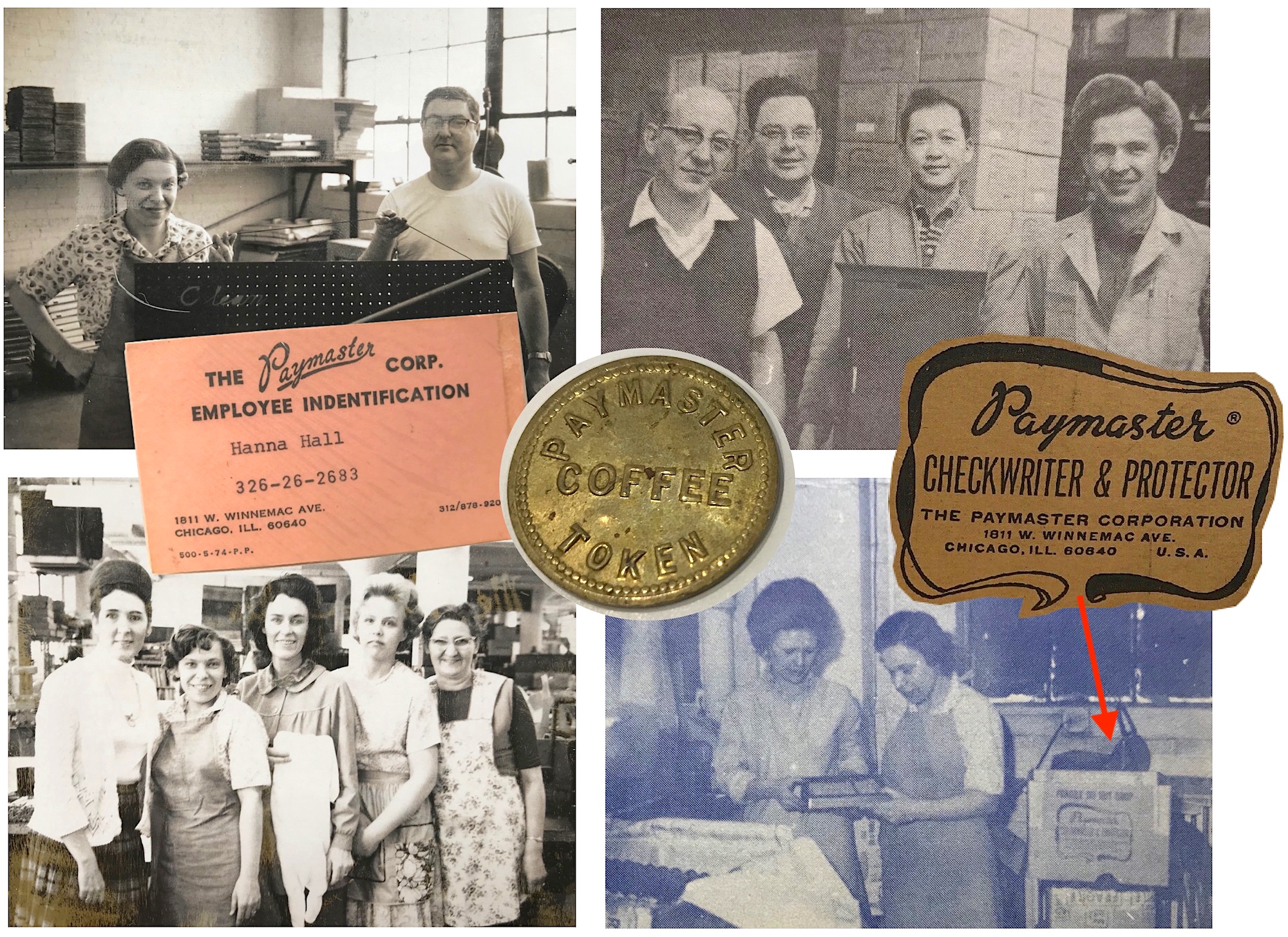
[Top Left: Hanna Hall and co-worker Richard Grau in the Paint Room, 1968. Top Right: Don Hall (far right) with Mike Stiava, Ken Heyser, and Tom Tsuruda, 1963. Bottom Left: Hanna Hall (second from left) with Elizabeth Richards, Shelia Creed, Ulla Nelson, and Wanda Schmeichel, 1968. Bottom Right: Hanna Hall (right) with Erma Barnes, 1969]
Like his wife, Don Hall remained at Paymaster for over 30 years, eventually making service calls around the city, helping clients out with on-the-spot machine repairs. [Pictured below: Cover of the Paymaster company newsletter, “Chatterbox,” from November 1964]
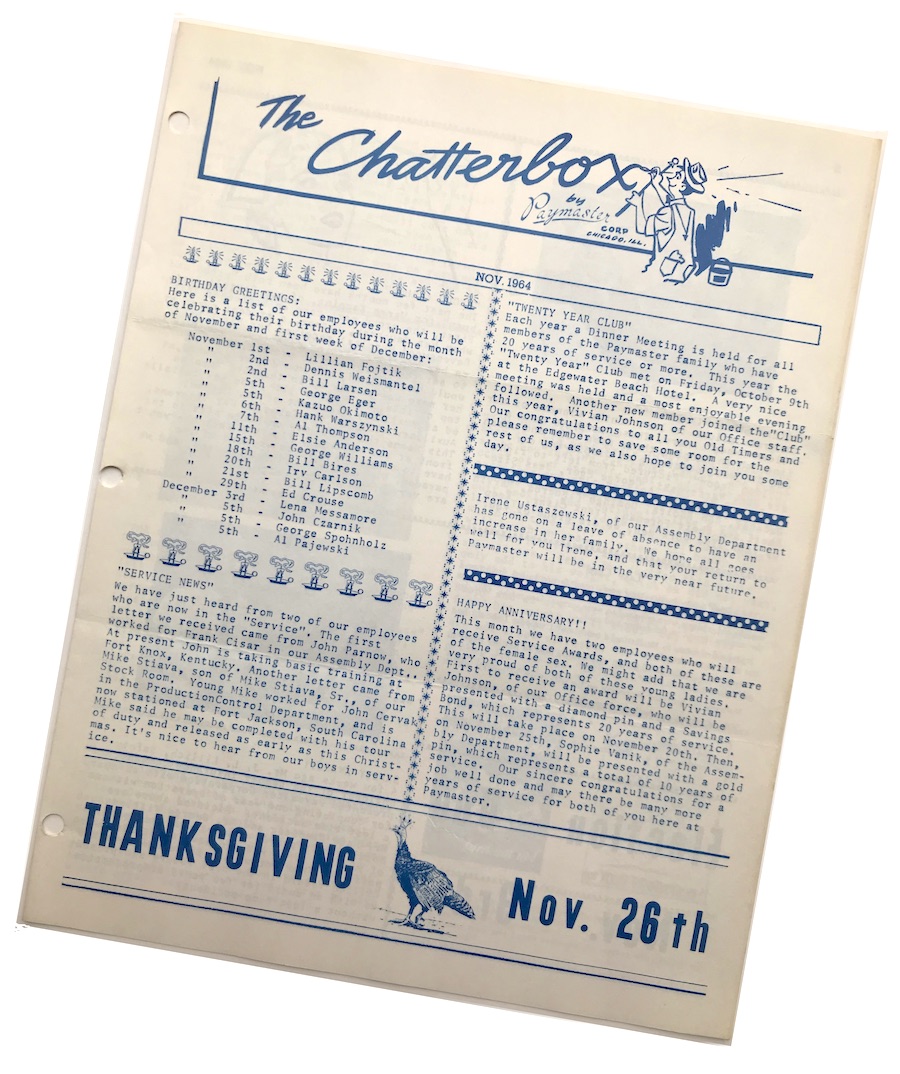 “My folks asked me a few times, while I was in high school, if I wanted to work at Paymaster during the summer,” William Hall says. “I declined each time, telling them I did not want to rise as early as they did. This was because they got to the factory each day about one hour before starting time after a minimum 30-minute commute; mainly just to get a parking space inside the small company lot. They would then sit in the lunch room, drink coffee, and read the paper until the starting bell. There was a certain employee during that early morning time who would regularly grab his favorite donut or sweet roll, lick it, and then loudly announce, ‘This one’s mine!’ as he put it back to be reclaimed at morning break time.”
“My folks asked me a few times, while I was in high school, if I wanted to work at Paymaster during the summer,” William Hall says. “I declined each time, telling them I did not want to rise as early as they did. This was because they got to the factory each day about one hour before starting time after a minimum 30-minute commute; mainly just to get a parking space inside the small company lot. They would then sit in the lunch room, drink coffee, and read the paper until the starting bell. There was a certain employee during that early morning time who would regularly grab his favorite donut or sweet roll, lick it, and then loudly announce, ‘This one’s mine!’ as he put it back to be reclaimed at morning break time.”
During this same period in the mid to late 1960s, Don and Hanna Hall would face a lot more challenges at the workplace than donut thieves and limited parking spaces, as the battle lines between Ted Hirschberg loyalists and union sympathizers were soon drawn.
Click below to read Hanna Hall’s Paymaster Employee Guide from 1975
paymaster-employee-guideV. Ted Jr: Union Buster
“Ted Hirschberg Sr. was one of the most brilliant and successful salesmen and businessmen in the checkwriter business. He taught me all I know, including making me first a mechanic, then a salesman for about five years, and then how to be an administrator and President of the Paymaster Corporation. His first consideration in business was always the salesman on the road and/or anyone connected with the Paymaster Corp. . . . I have carried on in the same tradition and at the same time have tried to make as many improvements for all concerned as were within my power, and I assure you that I am fully active in the business and will continue to do all I can for all concerned.” –Ted Hirschberg, Jr. writing in the January 1964 edition of the Paymaster “Chatterbox” newsletter following his father’s death
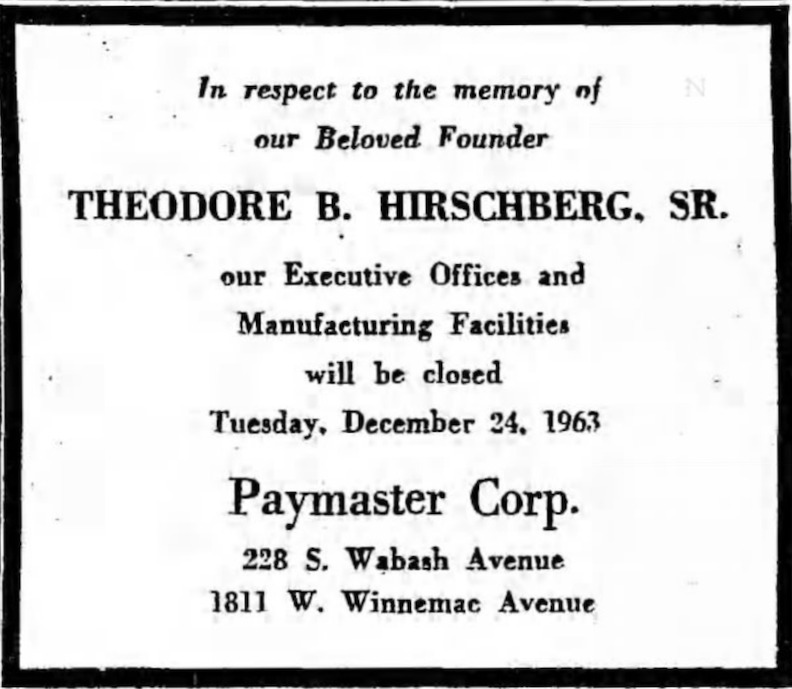
Paymaster founder Ted Hirschberg, Sr. died in 1963, leaving Ted Hirschberg, Jr. as the company’s unquestioned top dog. Rather than taking on a friendly father-figure role with his employees, however, Hirschberg Jr. started a reign of terror of sorts, going to war with his workers in a series of conflicts reflective of the divisive nature of the time period.
We begin with the 1965 case of “The Paymaster Corporation vs. United Steelworkers of America.” In this doozy, Hirschberg, Jr.—by then in his mid 50s—was accused of “unfair labor practices” after a series of alleged attempts to block the unionization of his workforce at the Winnemac Avenue plant. The levels to which he went to achieve this goal are both twisted and hilarious, and indicate a man whose business acumen didn’t necessarily overlap into personal leadership skills.
First, Hirschberg attempted to bribe employees with the promise of higher wages and benefits if they DIDN’T vote yes on a union. When he got in hot water for that, Hirschberg wrote a letter to all workers in which he found a passive-aggressive loophole for making the exact same bribes / threats.
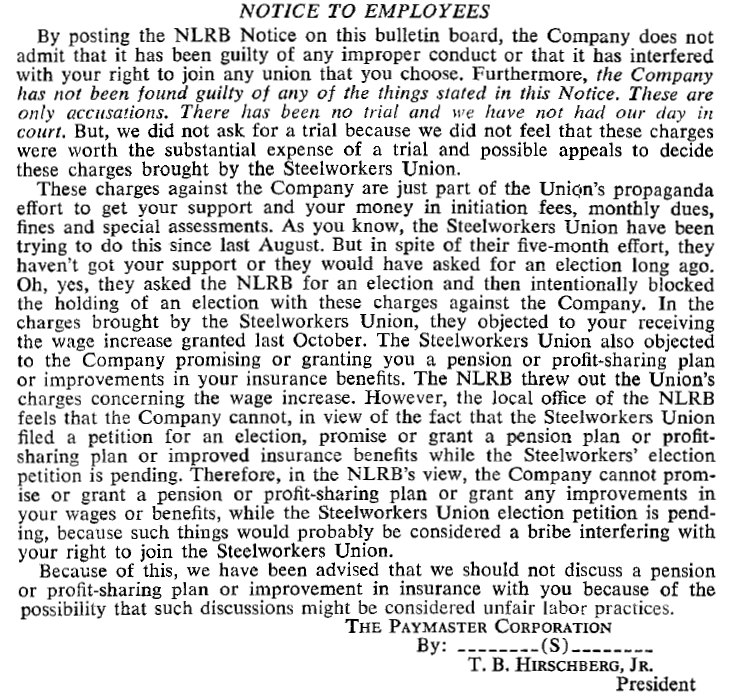
When the Steelworkers Union found out about THAT letter, they challenged Hirschberg again, leading to the “day in court” he’d seemingly wanted. In court proceedings, a whole lot of new insane Hirschberg antics came to light.
For example, there was a charge of “creating the impression of illegal surveillance.”
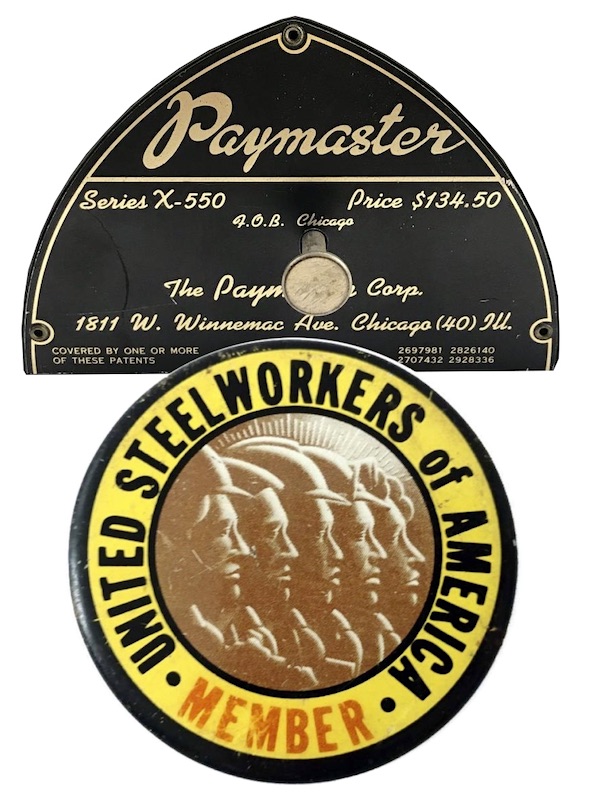 “On August 30, 1965, shortly before the end of the workday at Paymaster, Robert Christensen and another representative of the Steelworkers (Union) prepared for a leaflet distribution by stationing themselves on Winnemac Avenue, a public street on which the plant fronted. As employees emerged, they were offered these leaflets. Mr. Hirschberg, the president of the company, left the plant, accepted one of the leaflets, then crossed Winnemac Avenue and proceeded to watch further distribution while partially concealed by another building. Several employees told Christensen of Hirschberg’s presence. Hirschberg continued to observe for 20 or 30 minutes, occasionally shifting his position as the union representatives moved theirs. Christensen’s testimony on these events was not refuted. …Christensen also testified, without refutation, that on later visits to the plant, on September 14 and 20, during leaflet distributions, he observed George Williams, the plant superintendent, standing in the corridor of the plant which leads to its main exit, watching employees as they accepted his leaflets. A number of employees told Christensen about Williams’ presence.” — Decisions of National Labor Relations Board
“On August 30, 1965, shortly before the end of the workday at Paymaster, Robert Christensen and another representative of the Steelworkers (Union) prepared for a leaflet distribution by stationing themselves on Winnemac Avenue, a public street on which the plant fronted. As employees emerged, they were offered these leaflets. Mr. Hirschberg, the president of the company, left the plant, accepted one of the leaflets, then crossed Winnemac Avenue and proceeded to watch further distribution while partially concealed by another building. Several employees told Christensen of Hirschberg’s presence. Hirschberg continued to observe for 20 or 30 minutes, occasionally shifting his position as the union representatives moved theirs. Christensen’s testimony on these events was not refuted. …Christensen also testified, without refutation, that on later visits to the plant, on September 14 and 20, during leaflet distributions, he observed George Williams, the plant superintendent, standing in the corridor of the plant which leads to its main exit, watching employees as they accepted his leaflets. A number of employees told Christensen about Williams’ presence.” — Decisions of National Labor Relations Board
If spying from the bushes isn’t bad enough, how about straight up cursing out and insulting your workers?
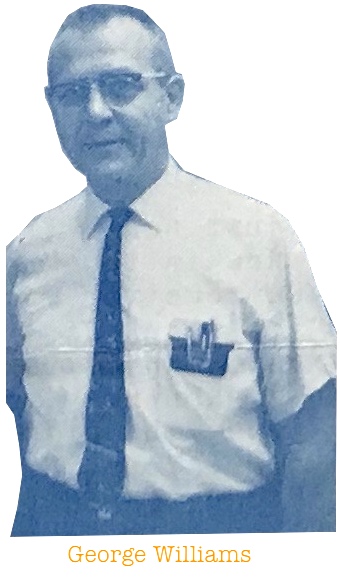 “Employee Anna Beauprey testified that she and a group of about 35 other women employees were called to a meeting in [George] Williams’ office sometime late in 1965. …Williams then called Hirschberg on the intercom to tell him about the meeting then in progress. Hirschberg came on and told the women that he was working on a profit-sharing plan and would let them know further in 30 days. The conference went on for almost 2 hours, until after the scheduled time for lunch. Williams then asked Hirschberg if they shouldn’t break for lunch, and Hirschberg answered with a vulgar, offensive remark about the women, repeated it, and then said, “To hell with the Union.” …That afternoon, the women who had heard Hirschberg’s unfortunate remark were recalled to the office and, again over the intercom, Hirschberg said that he had been kidding and asked them if they could not take a joke. Beauprey testified that all through the morning conference, Hirschberg’s speech sounded slurred, and although she had not seen him, it was her impression that he was drunk.”
“Employee Anna Beauprey testified that she and a group of about 35 other women employees were called to a meeting in [George] Williams’ office sometime late in 1965. …Williams then called Hirschberg on the intercom to tell him about the meeting then in progress. Hirschberg came on and told the women that he was working on a profit-sharing plan and would let them know further in 30 days. The conference went on for almost 2 hours, until after the scheduled time for lunch. Williams then asked Hirschberg if they shouldn’t break for lunch, and Hirschberg answered with a vulgar, offensive remark about the women, repeated it, and then said, “To hell with the Union.” …That afternoon, the women who had heard Hirschberg’s unfortunate remark were recalled to the office and, again over the intercom, Hirschberg said that he had been kidding and asked them if they could not take a joke. Beauprey testified that all through the morning conference, Hirschberg’s speech sounded slurred, and although she had not seen him, it was her impression that he was drunk.”
Still not feeling Mad Men enough for you?
Well, T.B. Hirschberg also publicly threatened to “beat the [expletive]” out of one of the more vocal, pro-Union Paymaster employees (Richard Munizza), adding that he would move the tables out of the cafeteria and bring in some boxing gloves before doing so.
To be fair, there was some aggression coming from the unionizers side, too. According to William Hall, when his parents Hanna and Don Hall crossed a picket line to continue working in the factory, the windshield of their car was smashed in. So yeah, there was some tension over there on Winnemac. Eventually, a court found in the Union’s favor in ’65, but punishment was light. Paymaster was basically told to stop doing all the illegal things they were doing.
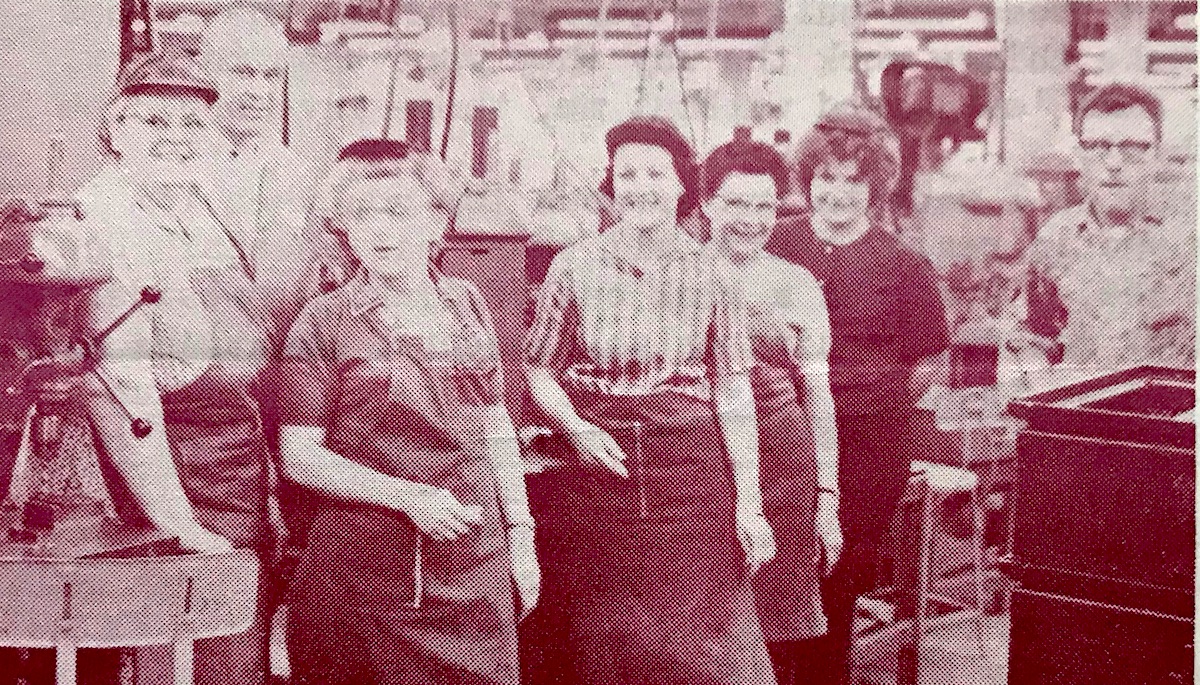
[Paymaster workers on the Drill Press line in 1965. Pictured far right is Richard Munizza, a pro-union worker who Ted Hirschberg Jr. threatened with violence around the time of this photo. Also pictured, from l. to r.: Katherine Anderson, Bruno Jonaitis, Florence Kolodziejski, Carolyn Smith, Bea Tubbs, and Eva Rivers]
Just a year later, though, Hirschberg was cited in a new $800,000 lawsuit, as a former Paymaster salesman claimed he was “slandered, libeled, and threatened with bodily harm” after leaving the company. The ex-employee, Thomas J. McLaughlin, had apparently tried to do what Hirschberg’s own father had done 50 years earlier—leave Paymaster to start his own check writer sales business. But Ted Jr. wasn’t seeing the parallels. Instead, according to a report in the Indianapolis Star:
“McLaughlin alleges that Theodore Hirschberg Jr., president of Paymaster; vice-presidents Robert E. Lewis and Irwin L. Schulman, and [Indianapolis agent] Walter Manning conspired to damage his reputation and drive him out of business as a competitor. Among McLaughlin’s complaints are that he was forcibly held in Manning’s office last January by two strongmen.
The complaint alleges that McLaughlin was told by Manning that if he should try to leave, the men were being paid $50 for each finger and $150 for each arm and leg they could break. During this alleged ‘imprisonment’ for an hour, the suit says, McLaughlin’s car was rifled of merchandise.”
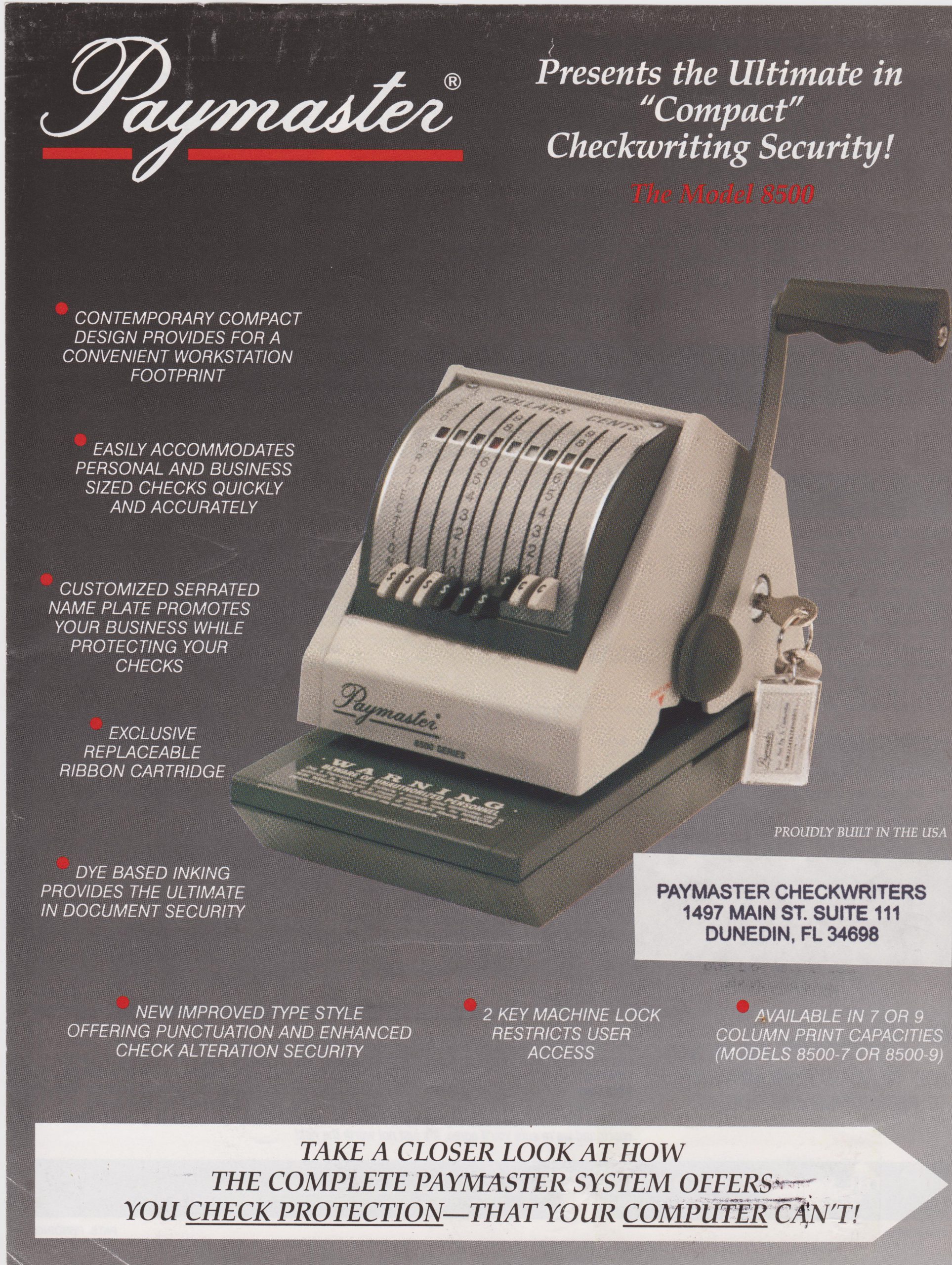 Thuggery and intimidation was nothing unusual in Chicago business, nor its government for that matter. Nonetheless, when Ted Hirschberg Jr. died in 1971, not everyone mourned the loss.
Thuggery and intimidation was nothing unusual in Chicago business, nor its government for that matter. Nonetheless, when Ted Hirschberg Jr. died in 1971, not everyone mourned the loss.
***
The Paymaster Corporation was still in business into the 1990s, but the rise of the digital age posed a gloomy horizon, sending thousands of heavy metal check machines out to pasture. For longtime employees like Don and Hanna Hall, it also meant a sad end to a way of life.
“My parents worked hard and had high hopes the U.S. Postal Service would keep Paymaster going with their new postal-centric machines,” William Hall remembers. “Unfortunately, the contract did not happen and the computer age closed the curtain.”
The company appears to have folded shortly before the new millennium, and the Winnemac factory was summarily demolished, as well, replaced with some modern walk-up apartments. For all that Paymaster machines had done to protect businesses over the decades, they ultimately couldn’t protect the one manufacturing business that produced them.
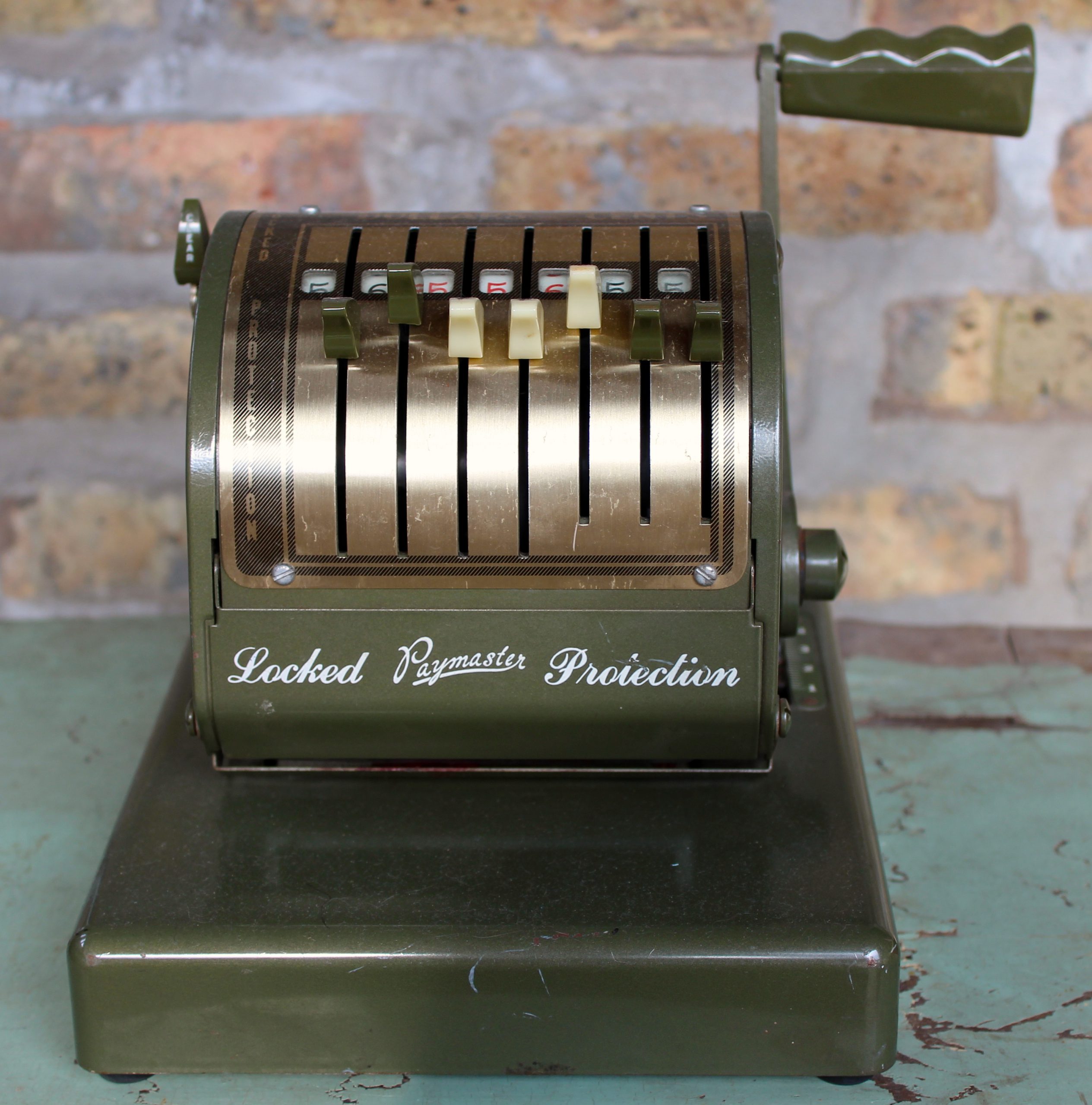
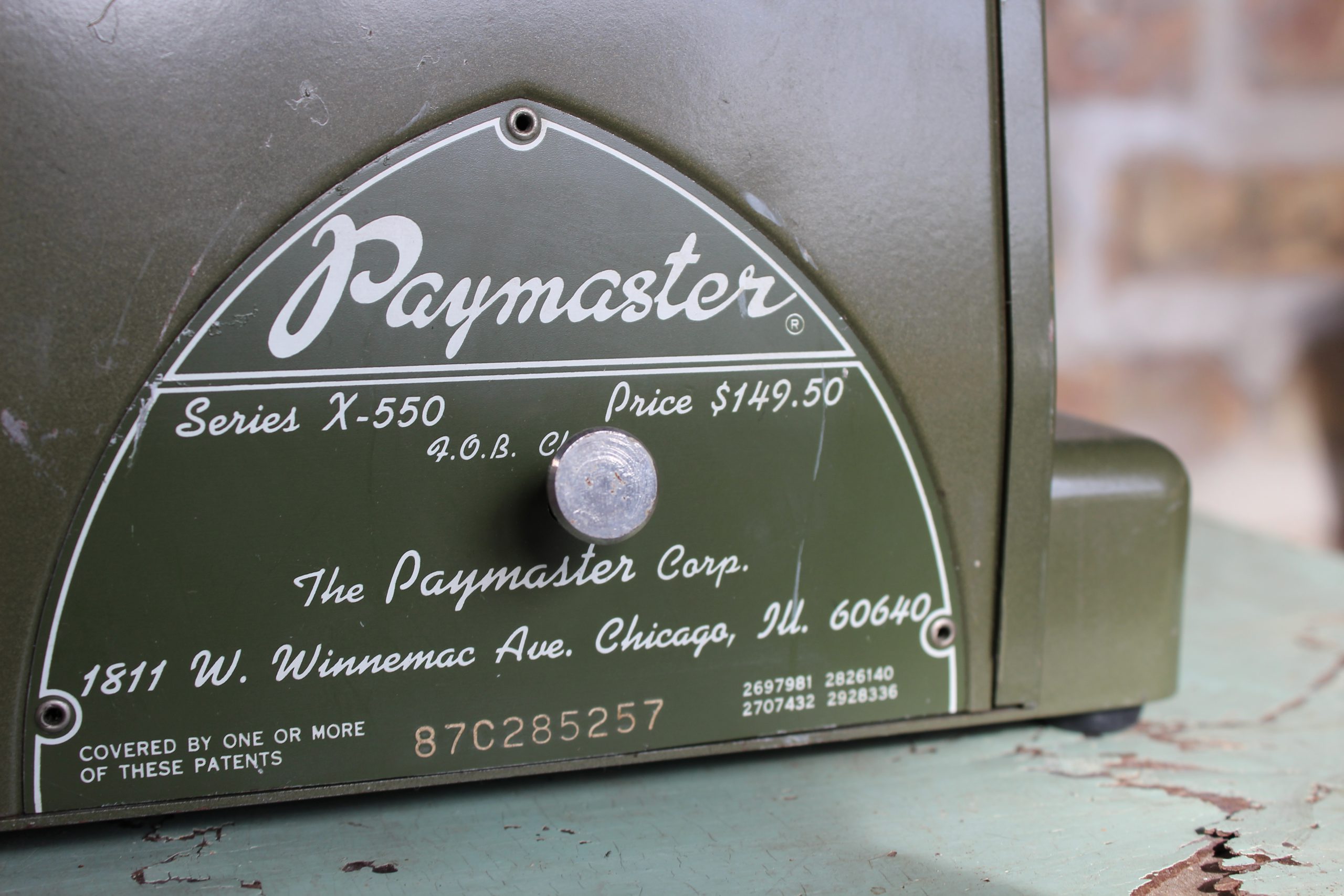
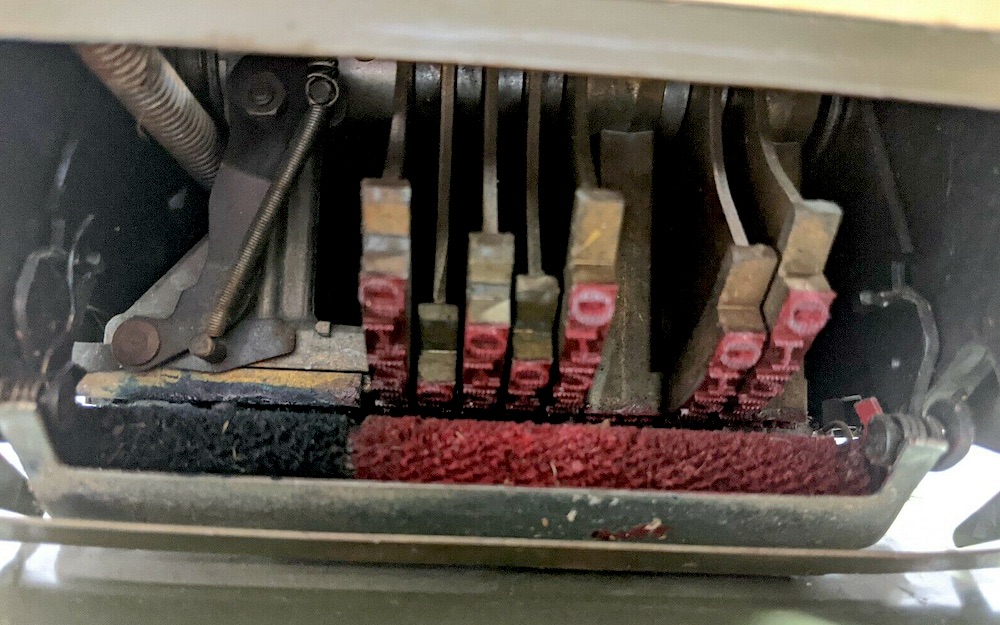
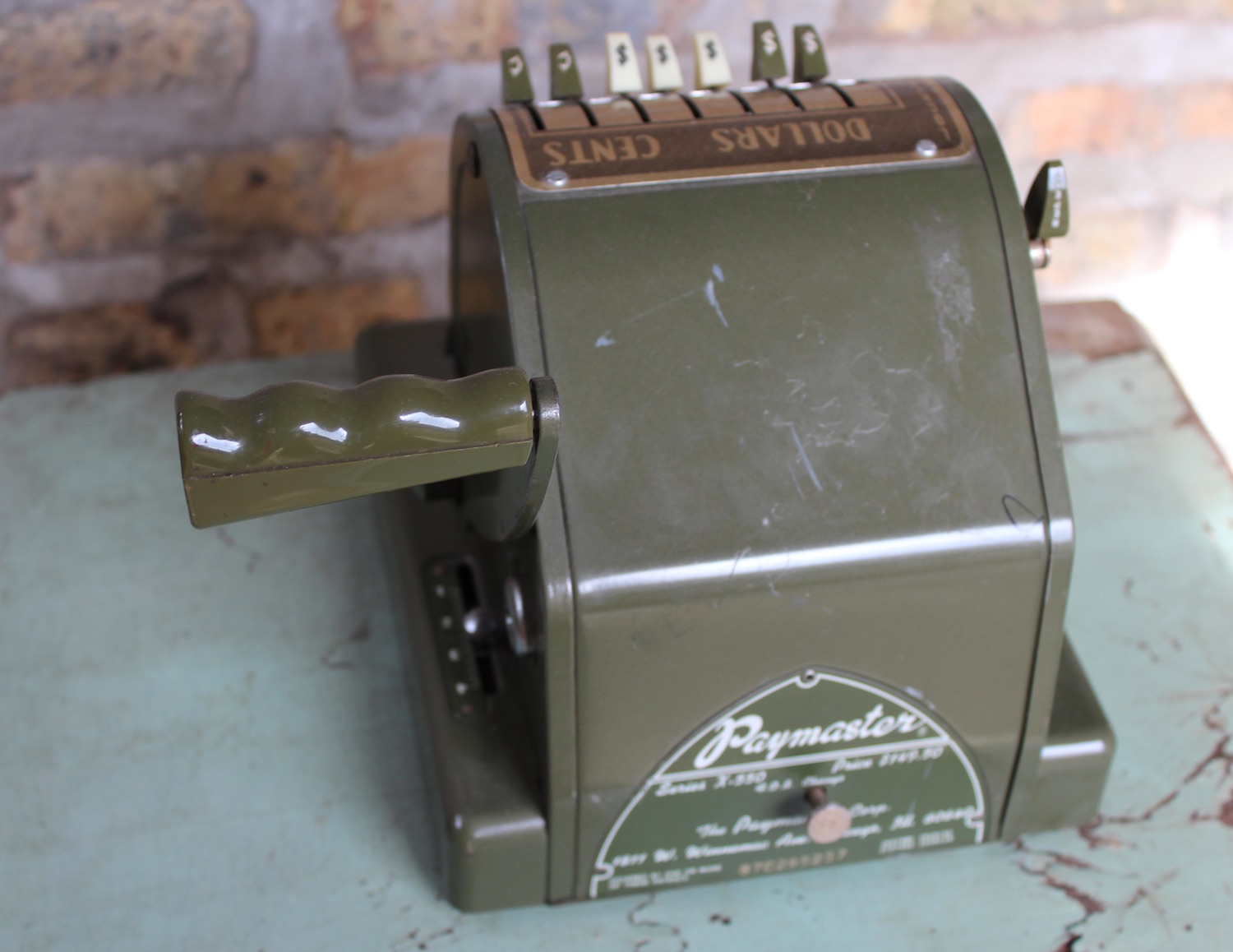
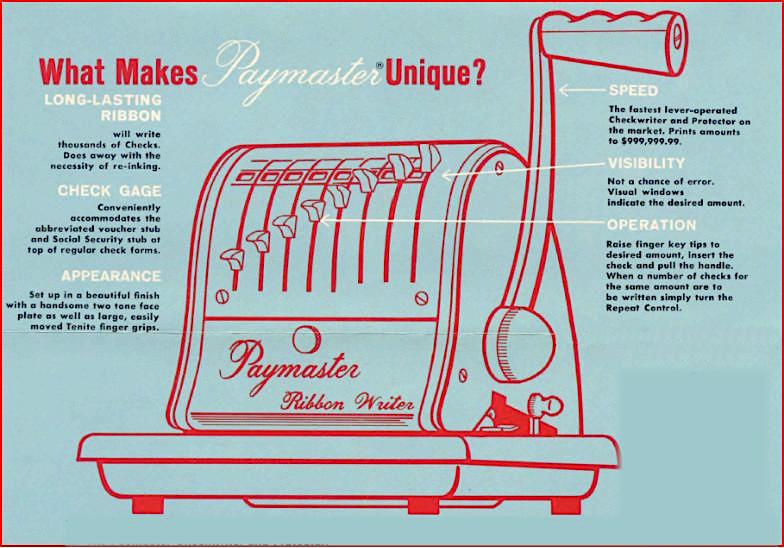
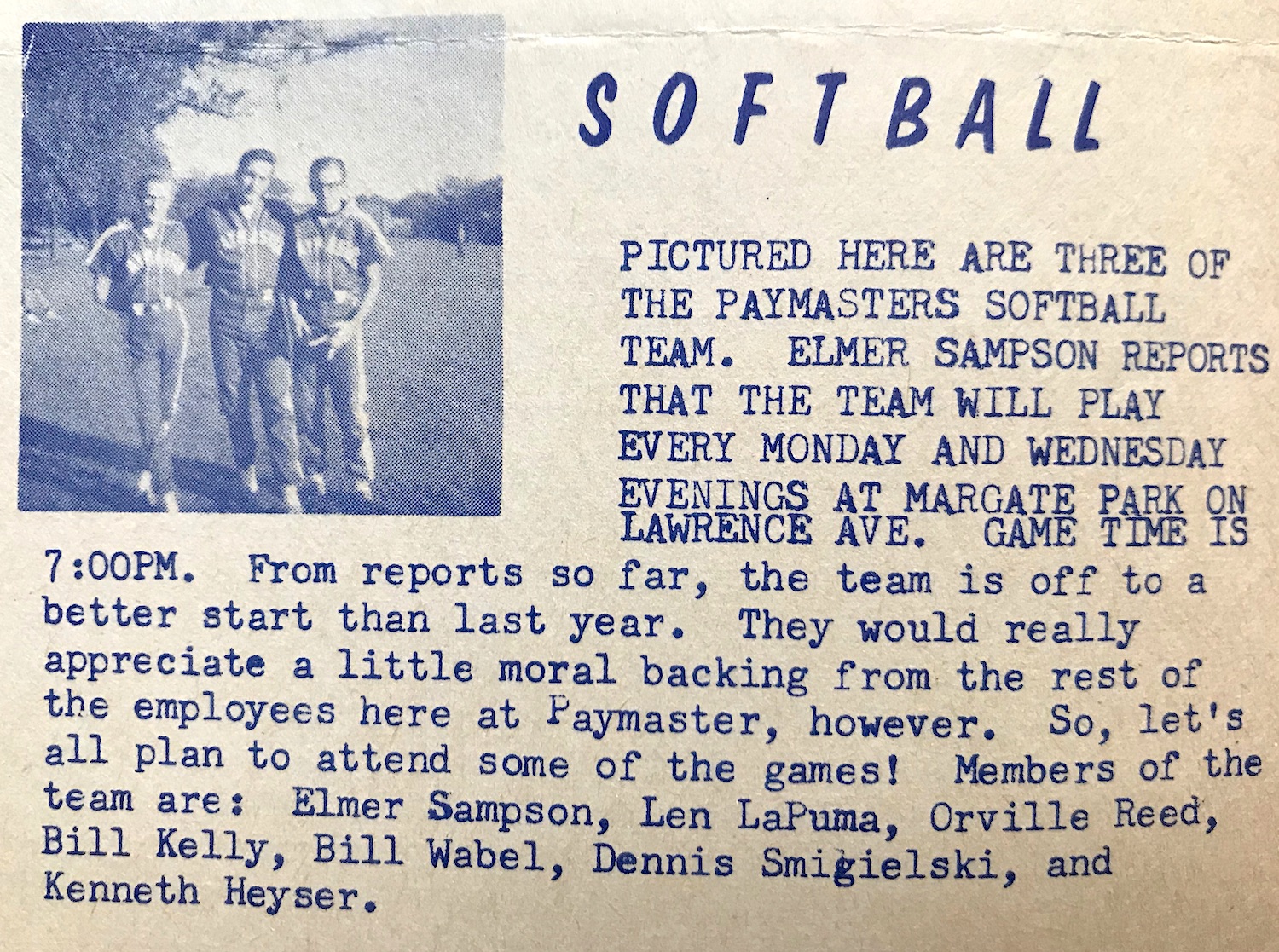
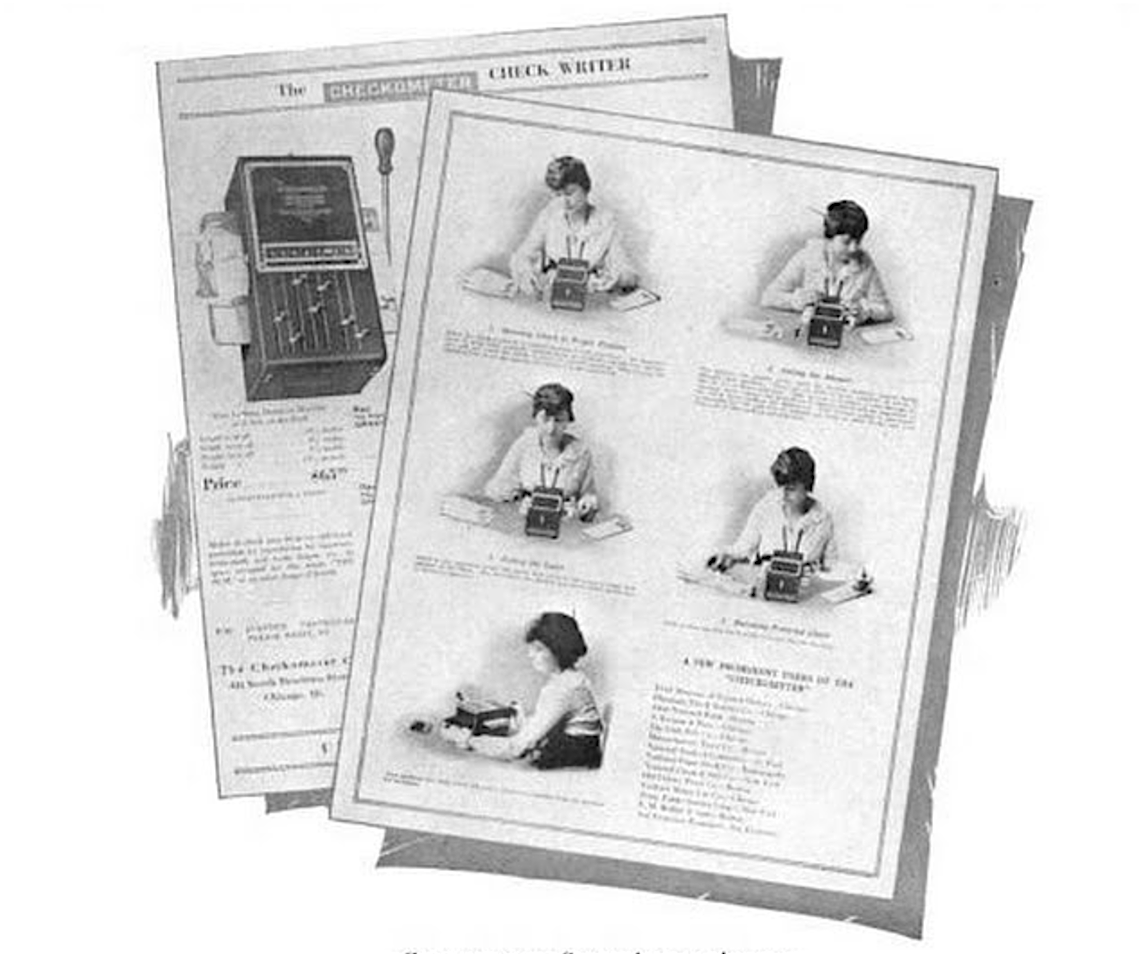
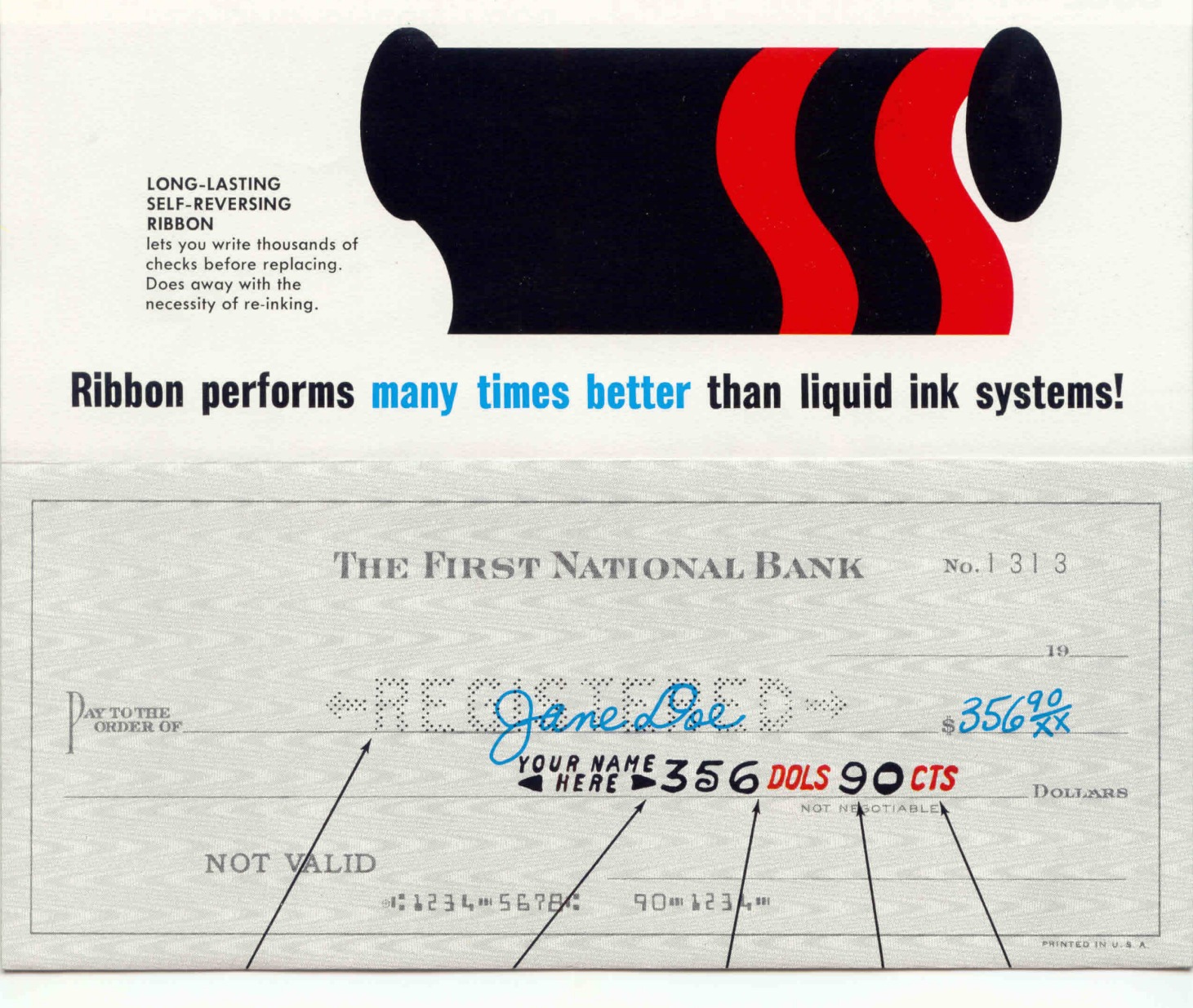
Sources:
Letter from William Hall, son of Don and Hanna Hall, 2020
Paymaster Company Newsletters – “Chatterbox” and “Facts & Faces” – 1962-1977
Paymaster Employee Guide, 1975
Paymaster Sales Manual, 1951
Decisions and Orders of the National Labor Relations Board, Vol. 162, 1968
“Check Writing Machine” patent No. 2,697,981
“Tood Protectograph Co. vs. Hirschberg” – Supreme Court, Special Term, Monroe County, June 19, 1917
Sales Management, Dartnell Corporation, Vol. 71, 1953
“Businessman Files Libel Suits Totaling $800,000” – Indianapolis Star, May 28, 1966
“Hot Property” – Los Angeles Times, September 22, 1985
Archived Reader Comments:
“I worked for Walt at the Night Flight at 38th & Keystone good man” –Mark Allen, 2019
“In 1971 Robert Louis Bought paymaster corporation I was hired by Walter Manning in 1967 he taught me how to switch machines in other words if you had a machine and you dealt with me you were going to get another one I sold 600 check writers a year made a lot of money went from town to town with 20 check writers of my truck works four days a week. Partied all weekend had a girl in every town I sure miss it.” –Tim Long, 2019
“My grandfather end uncle were both salesmen for paymaster. Don’t know when they started. But at least in the late 1950s ir early 1960s. They came to Californis and eventually ended up in the San Francisco region where the both represented Paymaster for well over 20 years. My grandfather retired in the mid 1970s, my uncle in the mid 1980s. Everytime I visited they used my as a Guinea pig for sales pitches and demonstrations. Seemed they always had one CV or 2 machines they tinkered. And the machines seemed so mysterious to a kid’s eyes. They were very solidly built, that’s for certain.” –PJ, 2019
“My dad worked for Walt and Virginia Manning for over 30 years out of the Indianapolis office.
I also worked for Walt for a short time in the late 1960s. Walt was a hard living, hard working man with a my way or the highway attitude!” –Brad Wagnon, 2019
“I came to Chicago in 1957… now I am 85 years of age and a Danish citizen. Upon my arrival in Chicago I applied for a job at The Paymaster Corporation’s downtown Office at N. Wabash. As a foreigner..I was happy to get a job there although the job as accountant was bit below my educational level.
Anyway….it suited me fine, as I had enrolled at Northwestern University’s evening division where I studied Industrial Management. Management was very friendly and treated me, a Danish person, very Well. After a couple of years I went on to San Francisco… to work for another Chicago based firm: The Charles Bruning Co.” –Regards, Kai Jørgensen, Denmark, 2018
“Both of my parents worked there for years, as did my grandmother and aunt and uncle! My mother started out as a spray painter, and later became a supervisor of that dept. That’s where my parents met. My dad worked as an inspector, and my grandma and aunt and uncle were assemblers. My dad left not longer after they last tried to unionize in the late 70’s and went to work for S &C Electric. My mom left in the mid 80’s to finally become a stay at home mom. My grandma retired in the late 70’s, after working there for 25 years. I remember hearing the company changed its name in the early 90’s, but can’t find any information. Do you or any of your readers remember?? Thanks in advance! ” –Karen, 2017

I have a paymaster series 700 in excellent condition. Original cover too.
Do you know how much is worth? Anyone interested?
I have a 550. I want to use it in the business to send royal checks to authors. I need to re-ink and I found ink at Amazon. Does anyone have a user’s manual? I want to re-ink the dry felt properly. Also, could you let me know if there are any adjustments? Email: Fanninhj@gmail.com Are there replacement parts anywhere to be found?
Where can I find service manuals for these machines?
I have a paymaster series 8000. I have no key and there’s some rust. Wondering what it’s worth. Thank you
Where can I get my Paymaster series 7000 serviced?
I have paymaster Series 8000
Patent no. 8N369561
The Paymaster Corp. 1811 W. Winnmac Ave., Chicago, Ill. 60640
Just wondering how much they are worth and are they collectors. The one i have is mint green
I have a Paymaster S-1000. with plastic cover.. serial no. 7L36079..
mint condition. is it worth anything ?
I came across this article on Paymaster shortly before my father, Ted Superson (pictured here), passed away. I never got to show it to him, but he knew of it. My aunt Stella Zelasko (also pictured here) worked at Paymaster too. They walked home from work together every day. My father was a proud tool and die maker and talked to me about some of the people in these pictures.
I have a Paymaster 700 (RD21594). Can you tell me anything about it?
Do you have instructions or a link to online instructions on how to re-ink a Paymaster Series X-550 checkwriter?
I have the paymaster series 7000 serial number 8p87372 can anybody tell me if it is worth anything and it is in good condition and still has the ribbon and original paint.
I can’t wait to start writing myself checks!
I have the x-550 unit it has never been used
I have one if these paymaster machines a g 600 series are u interested in purchasing.
I have a paymaster X-900 , #7K264153. I would like to know more about it. Thank you so much.
Christine
I have a paymaster series: X-900 Price $353.50 the paymaster corporation 1811 W. Winamac Ave., Chicago, IL 60640 patent number 7K269627
Wanting to learn more about it!!!
we have a paymaster x-550 in excellent condition – still operating perfectly – any interest by a collector or museum?
Please email me at wdobi@shaw.ca
I have a Paymaster Series X-550 it has a few different patent numbers and is in excellent condition with the cover that goes over it. Is this something that I should hold on to and keep in my family? Is this a collectors item or are their many of these that were made? Where can I buy the ink and ribbon for it as well. Thank you for any information that someone can give me. SHALENA S
I have a paymaster series x550 made in Chicago 1811 w,winnemac ave it’s in great condition if any one is interested email me at wilbert.russell@yahoo.com
I have a Paymaster ribbon writer, series 8000
not sure what this number is 8N353743
Is the ribbon still available for this unit, if so what does it cost
Check Amazon. I just bought one from there. I am looking to see how to fix the ribbon advance system. For some reason ours is not working…
I have a Paymaster keyboard ribbon writer series 7000. Serial No. 8P54643. Are there collectors who might be interested in these machines? It’s in excellent condition.
Hi , I have one unit of the Paymaster with 8000 series . And the series number of the product is 8N193205. Is interesting to know the estimate manufacturing year of this product . And also need to know possible to buy the ribbon for this tems ?
Thanks !
i also have a paymaster Series 8000. the id # is 8N192085 it shows the cost of this machine to be $229.50.
It was used in my grandfather’s well drilling business…
I would appreciate any information you could give me about it..
Have a 7000 series found at a antique shop. What year made? Any idea where to get a new ribbon, it still works great. Thx